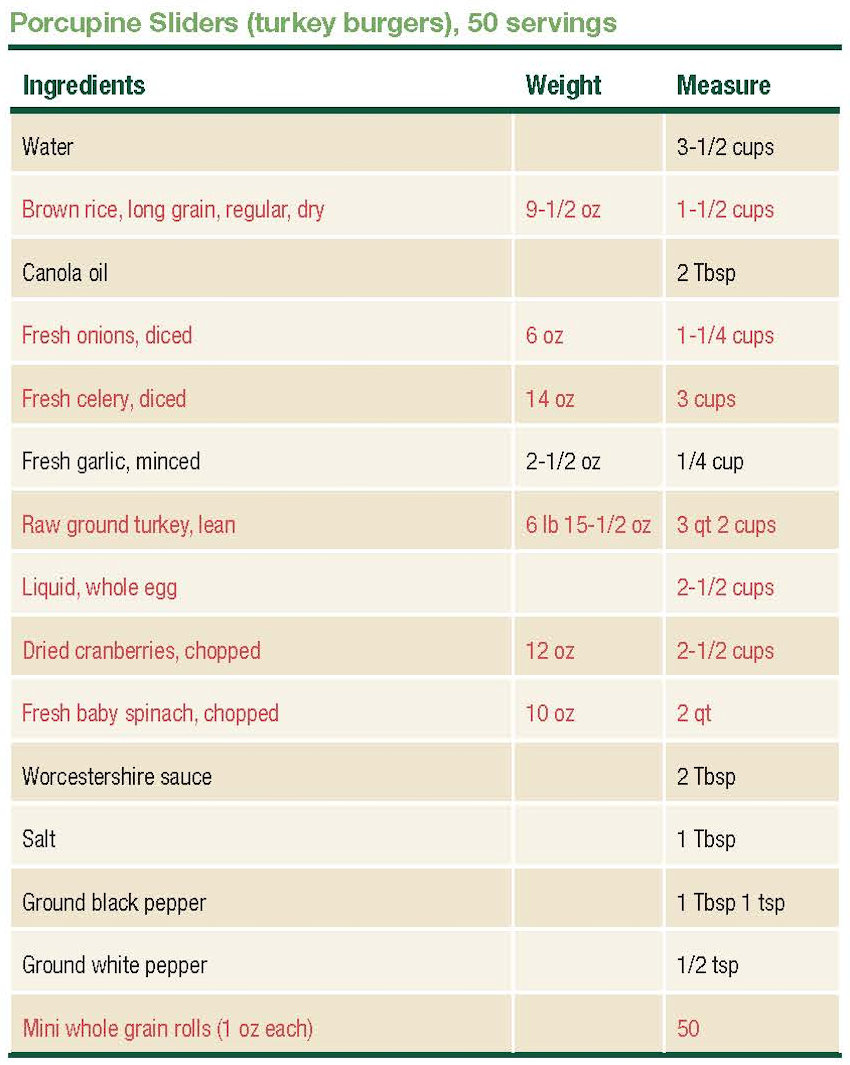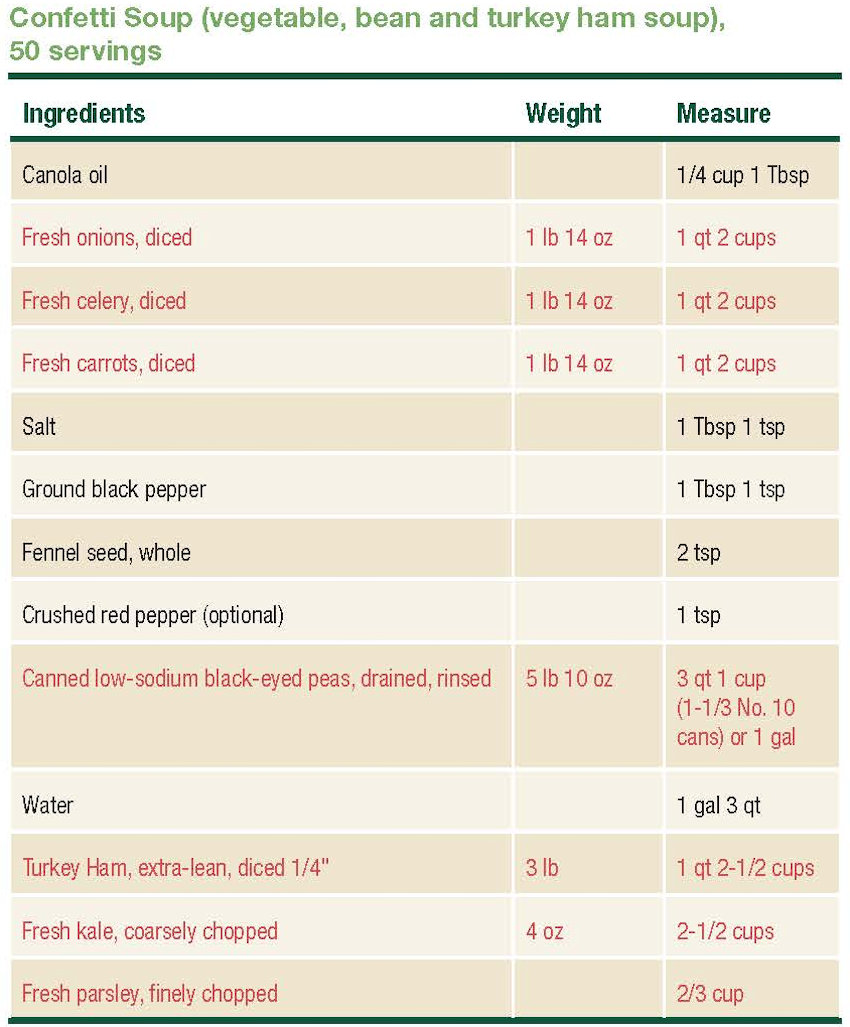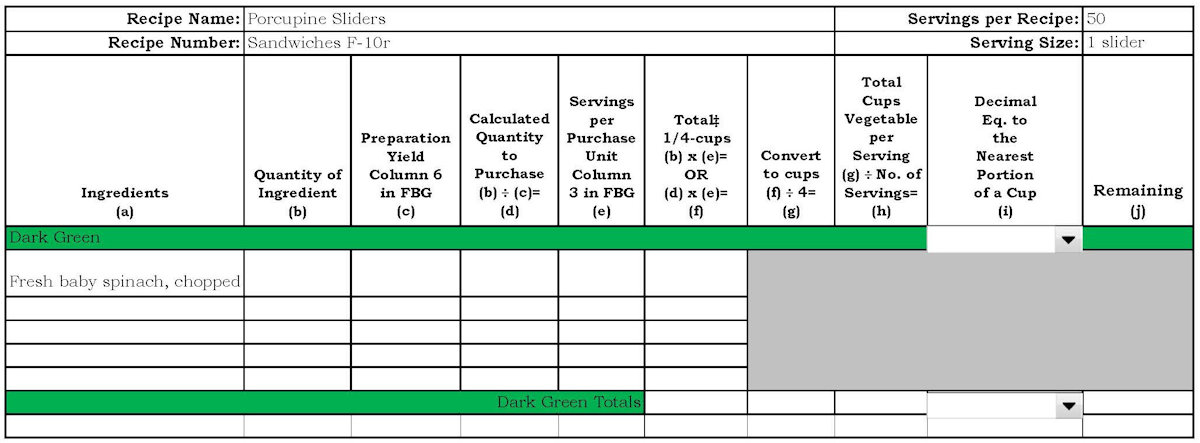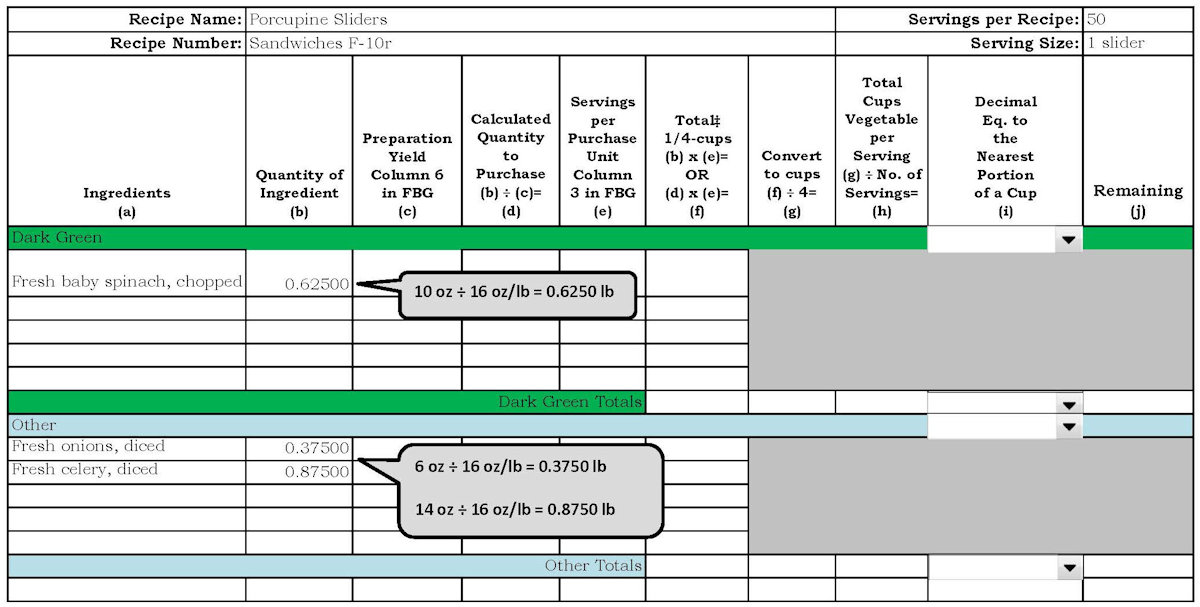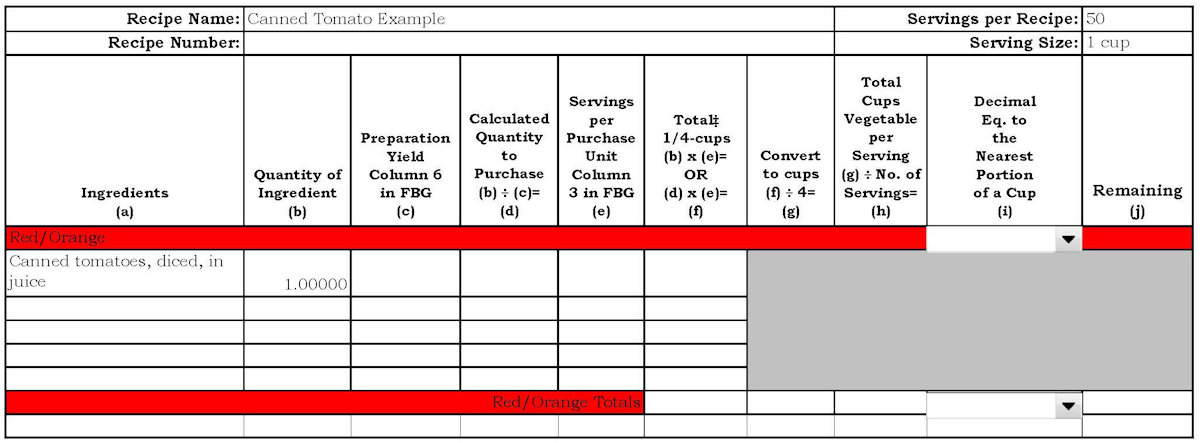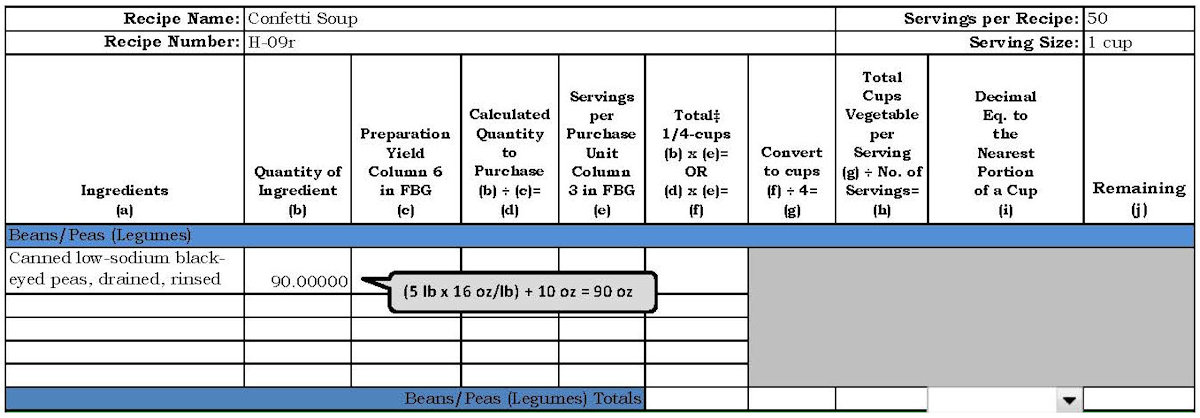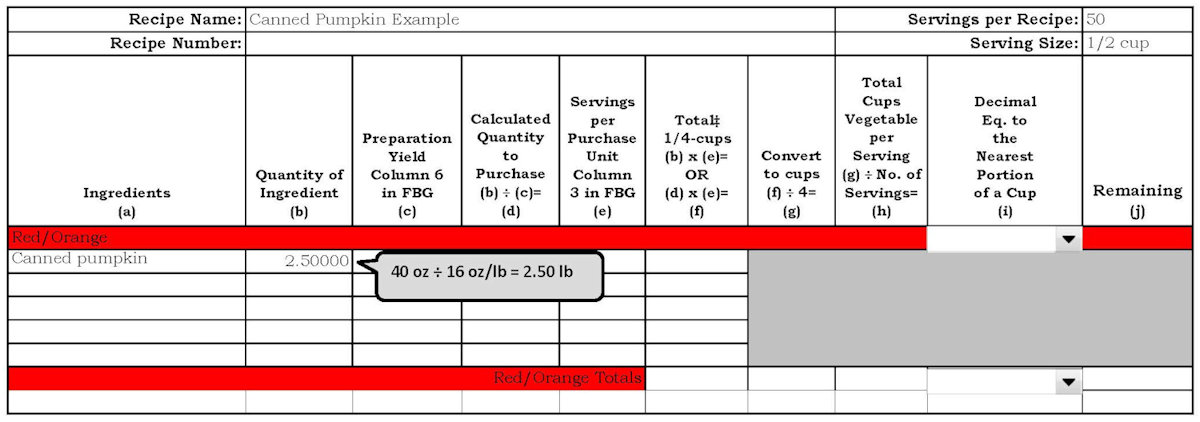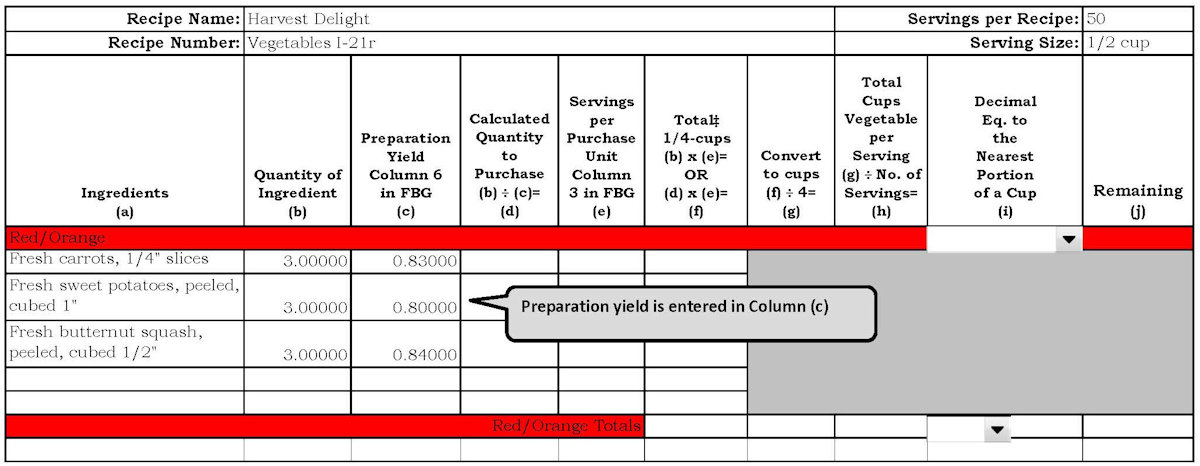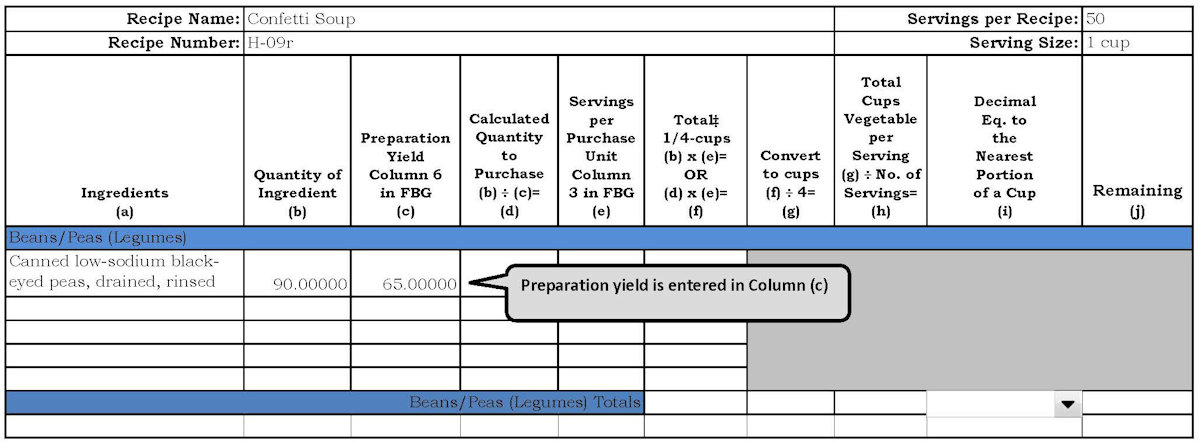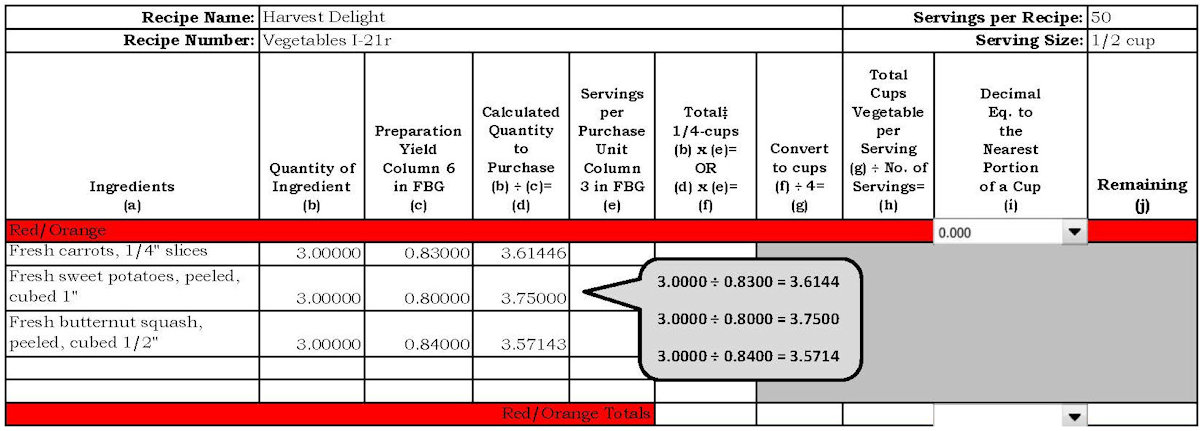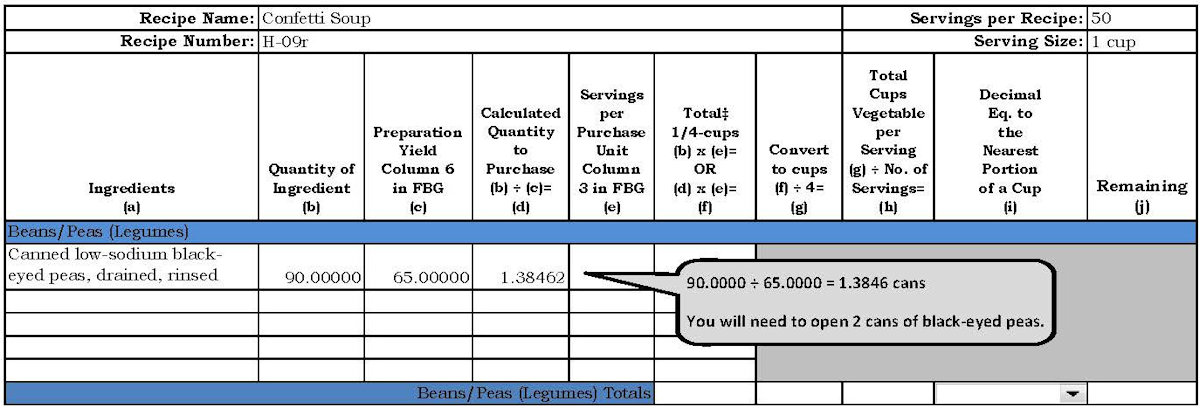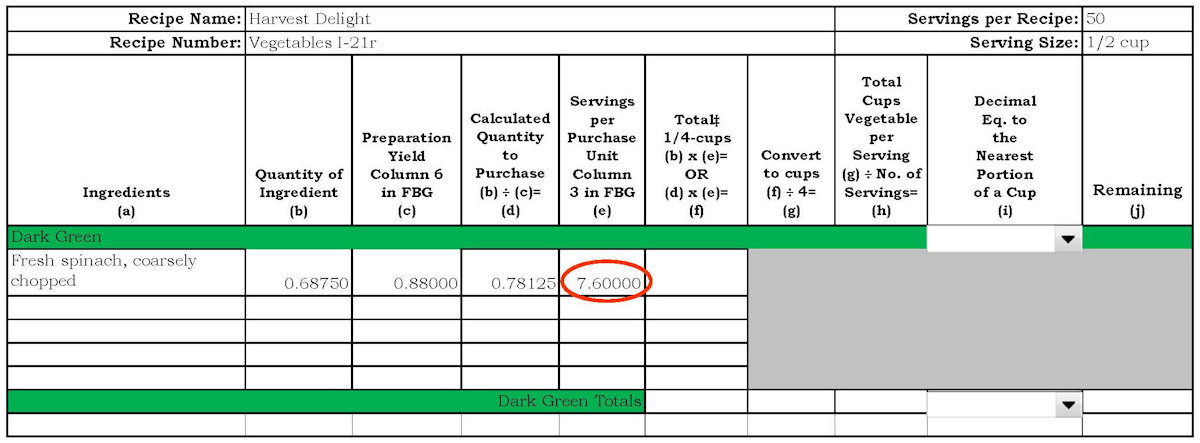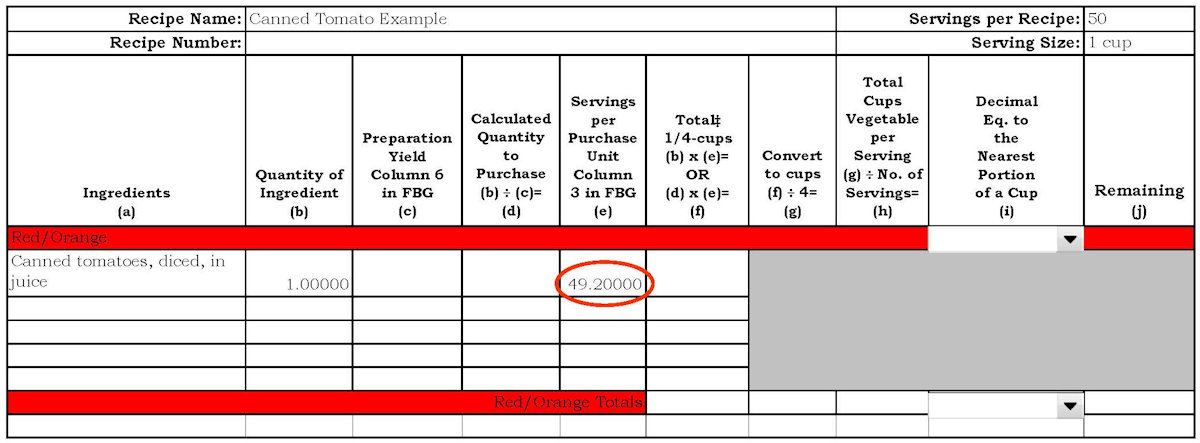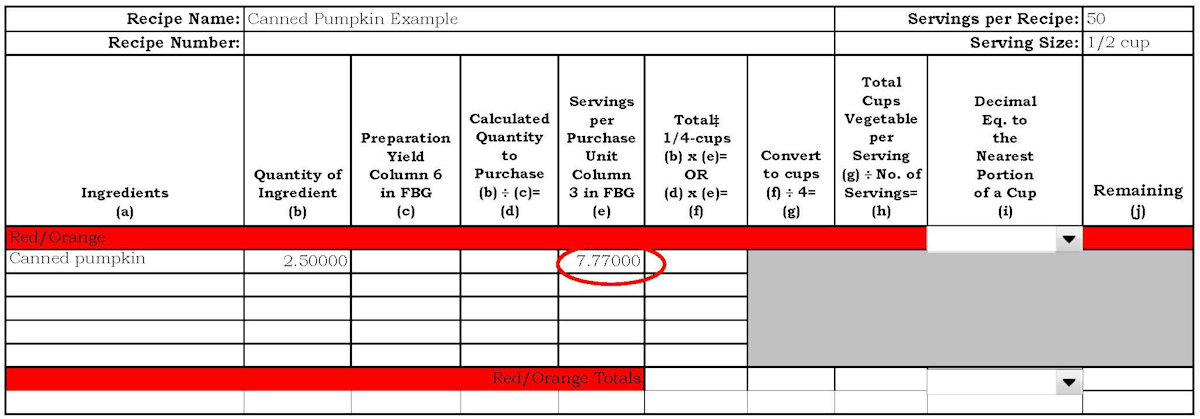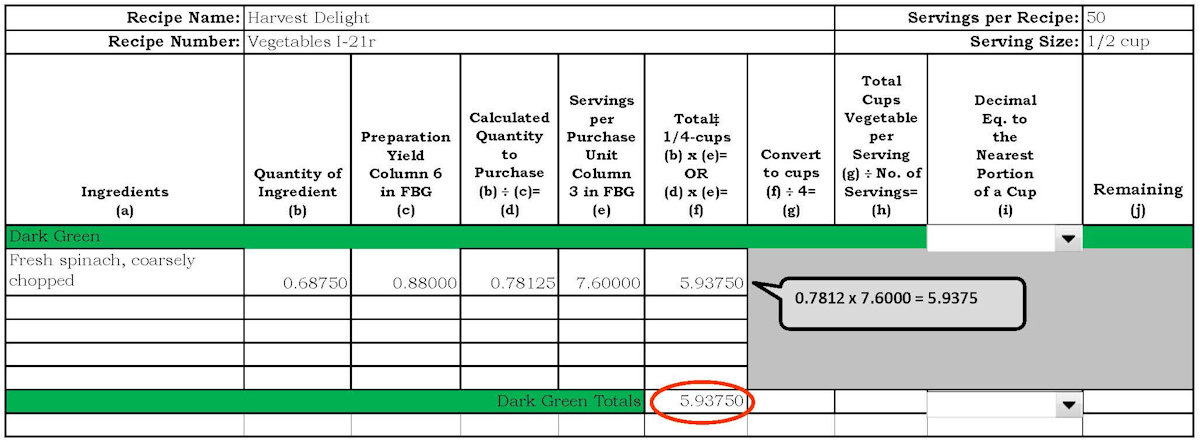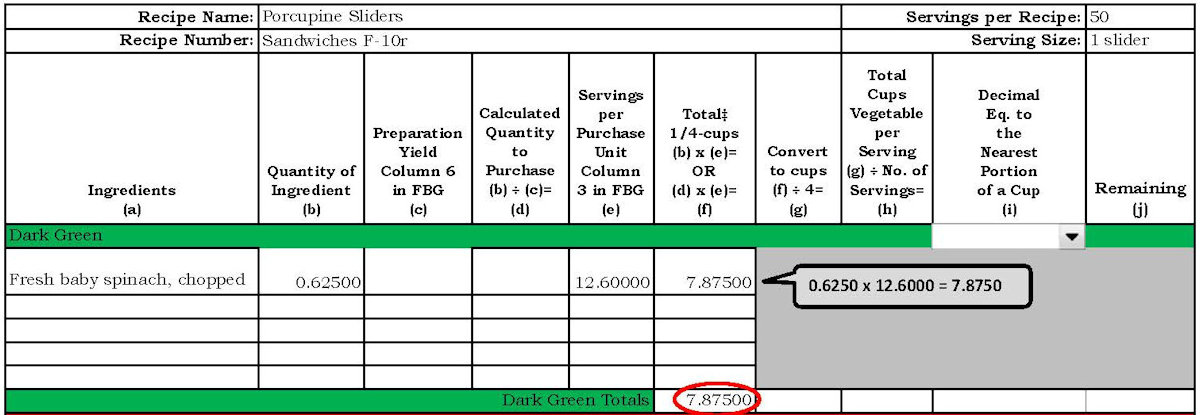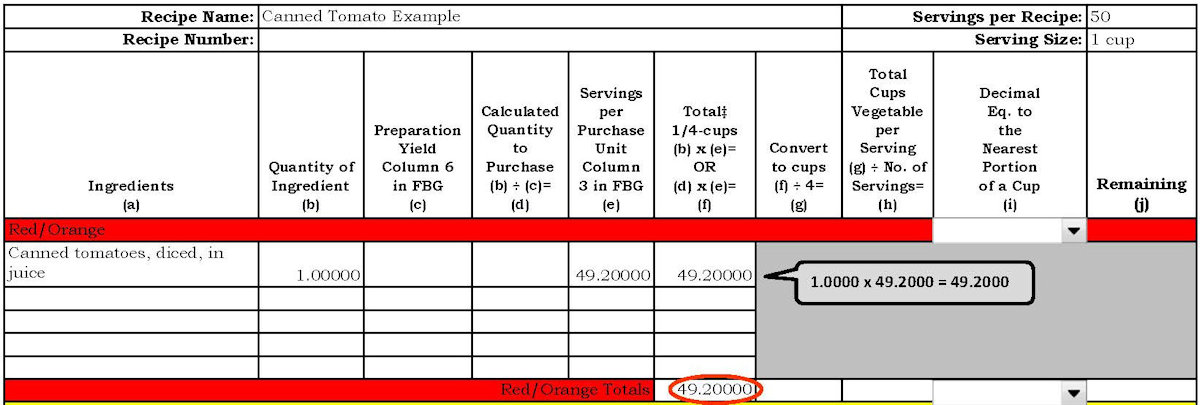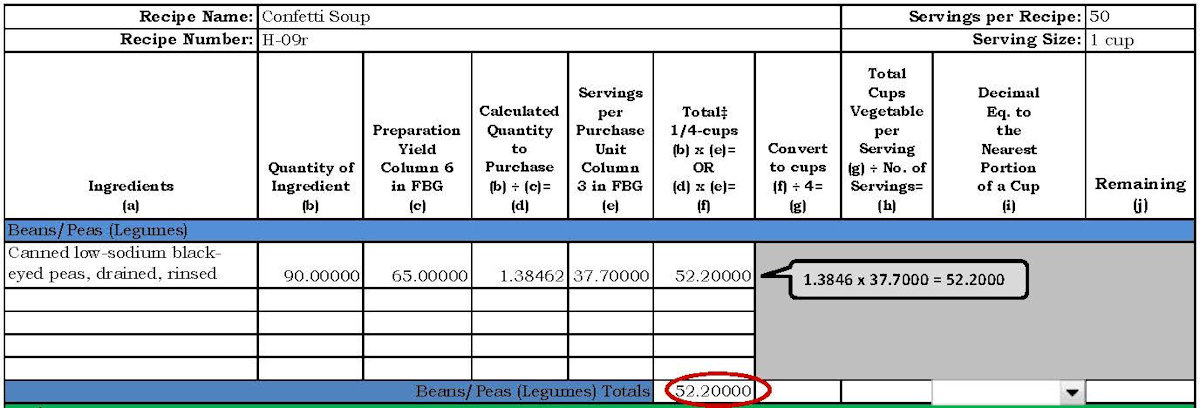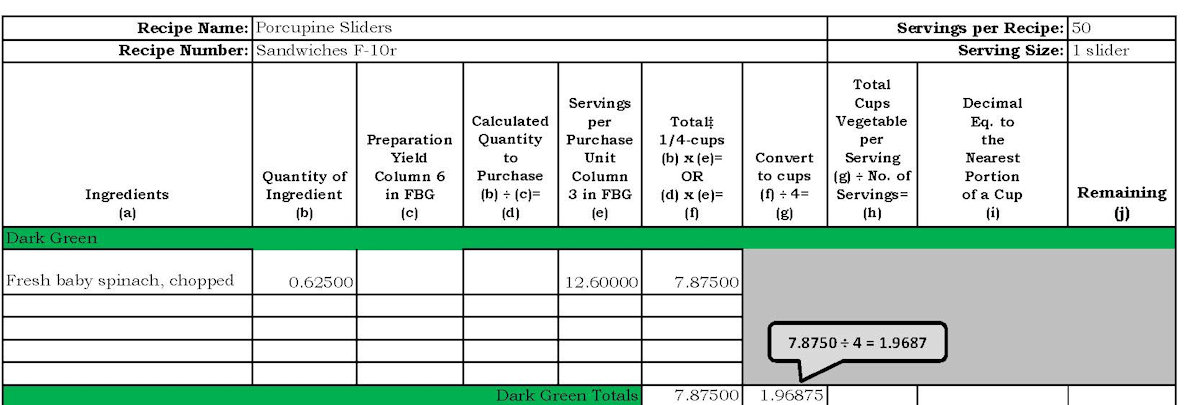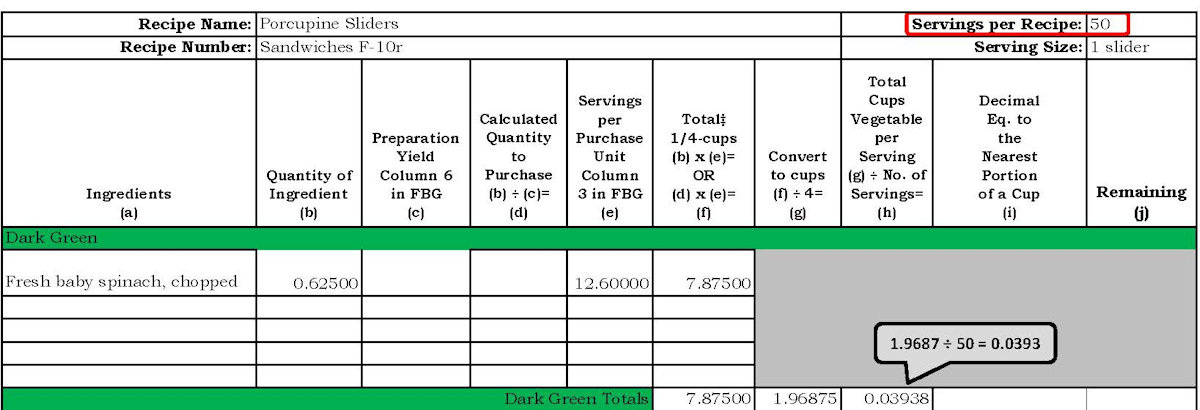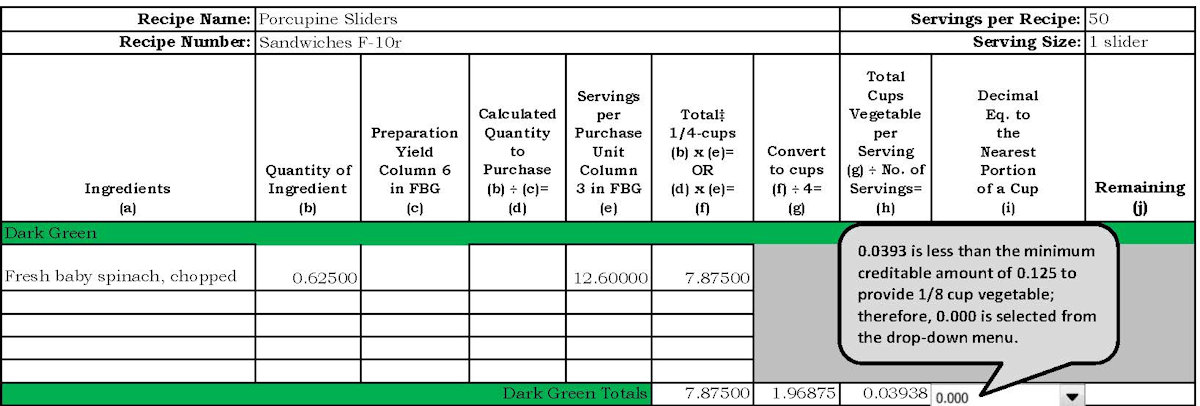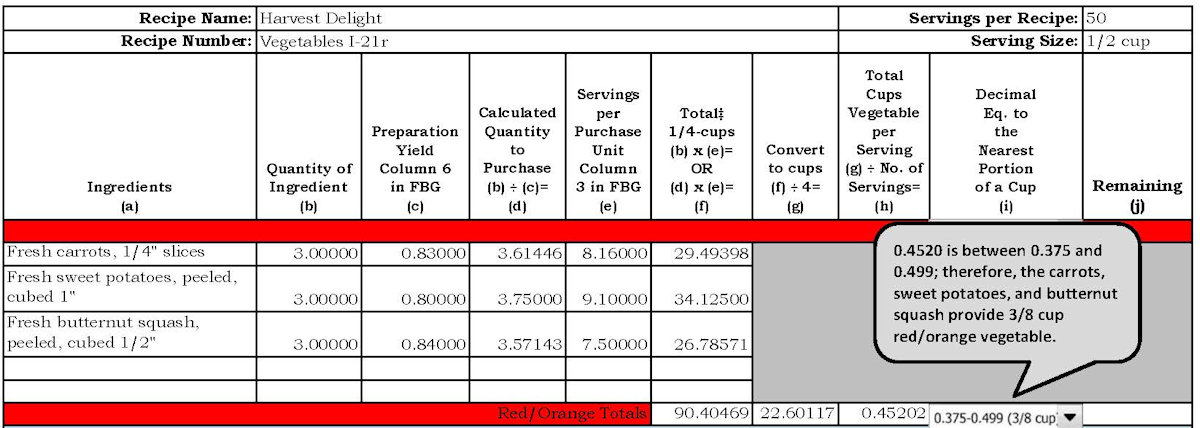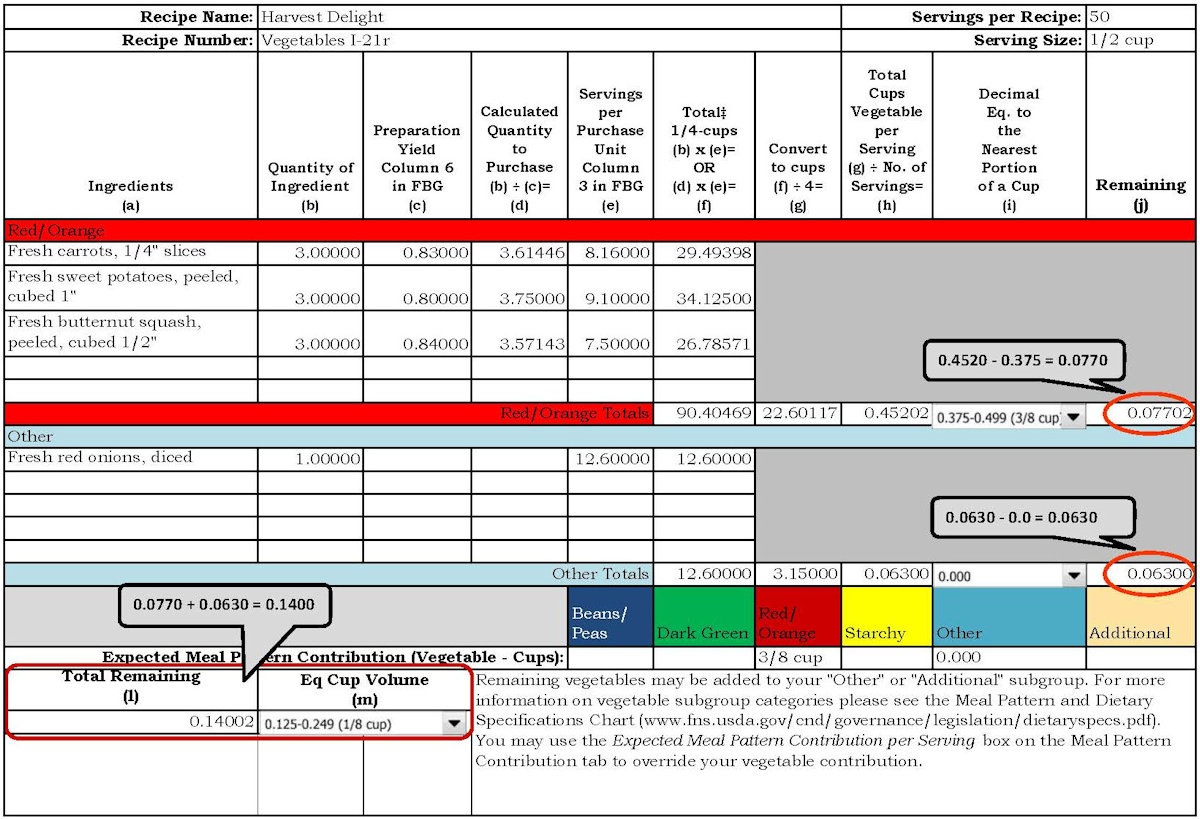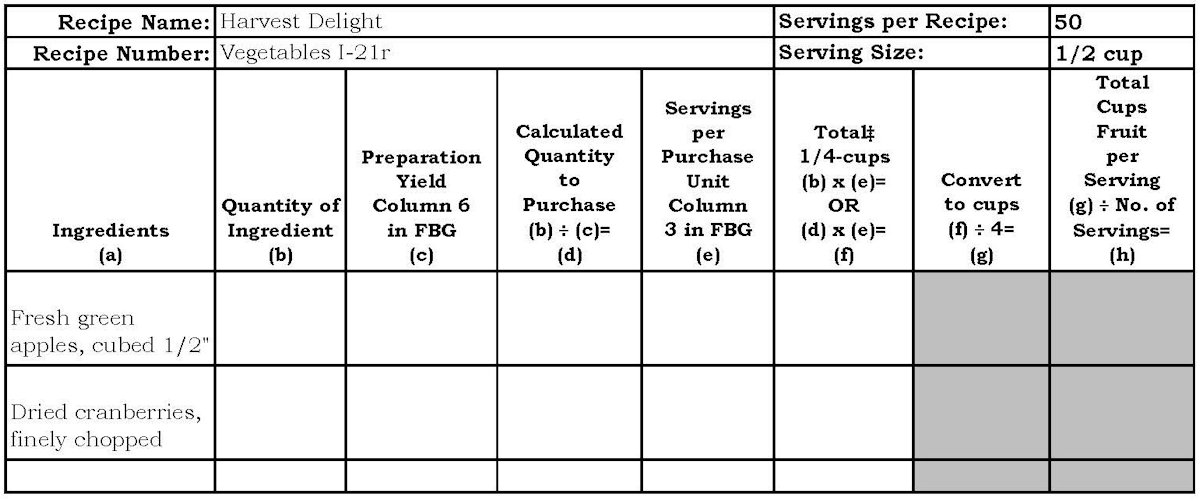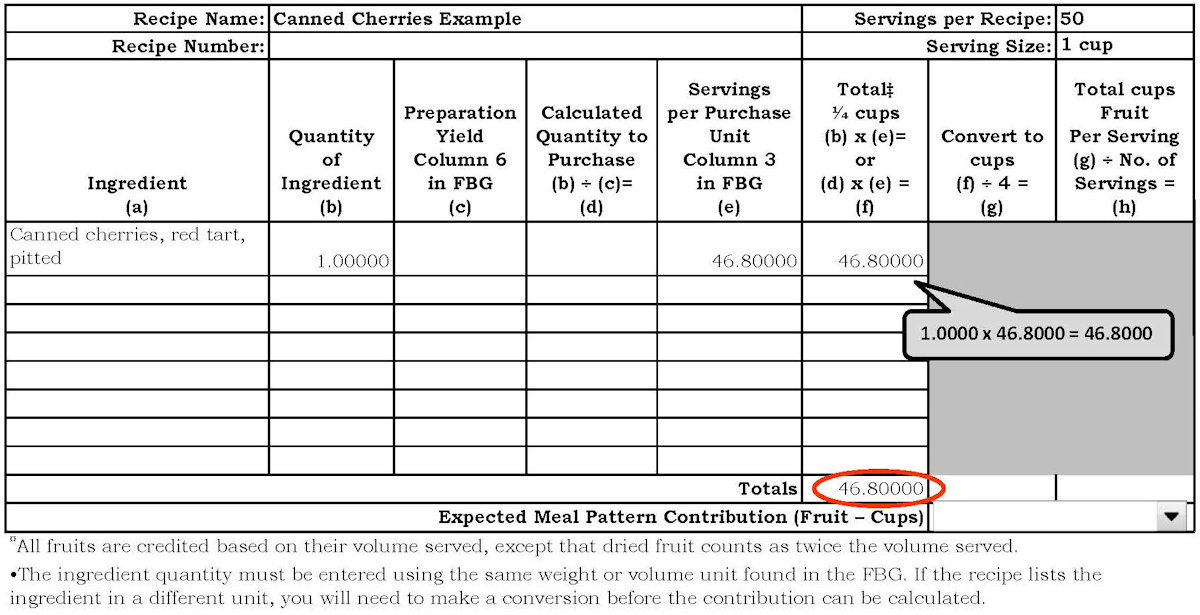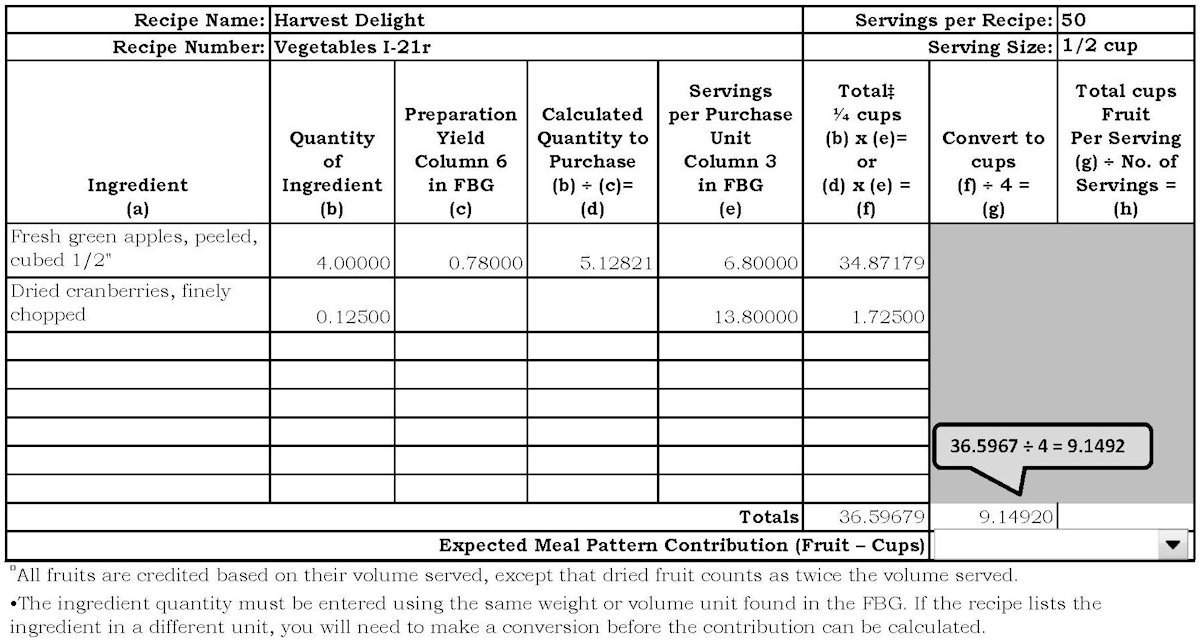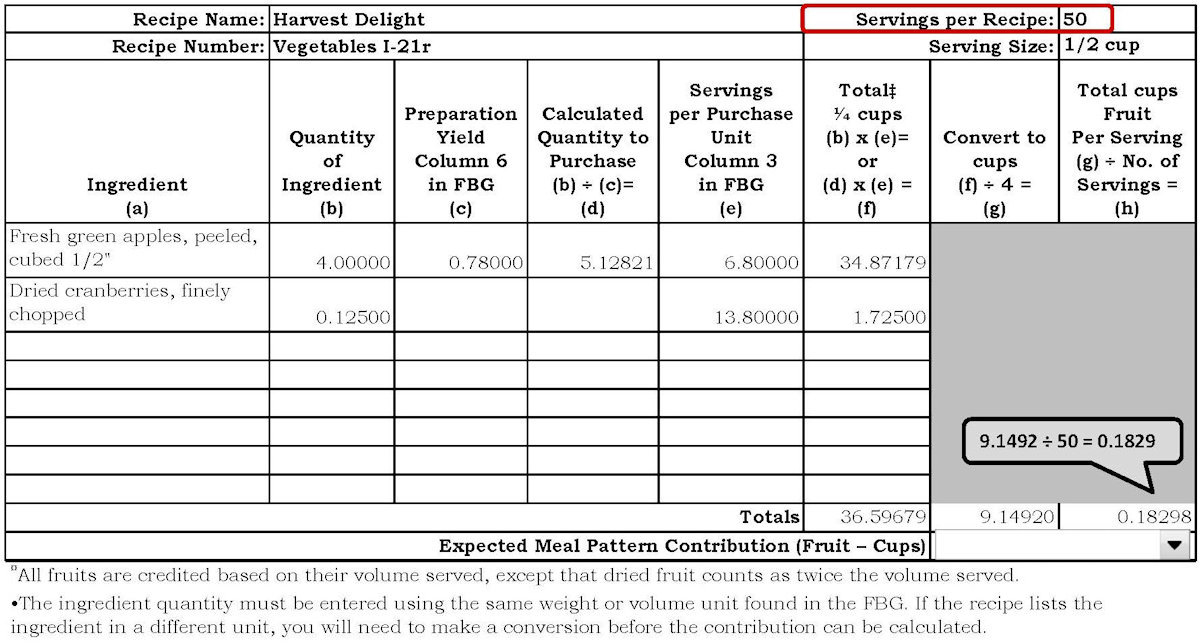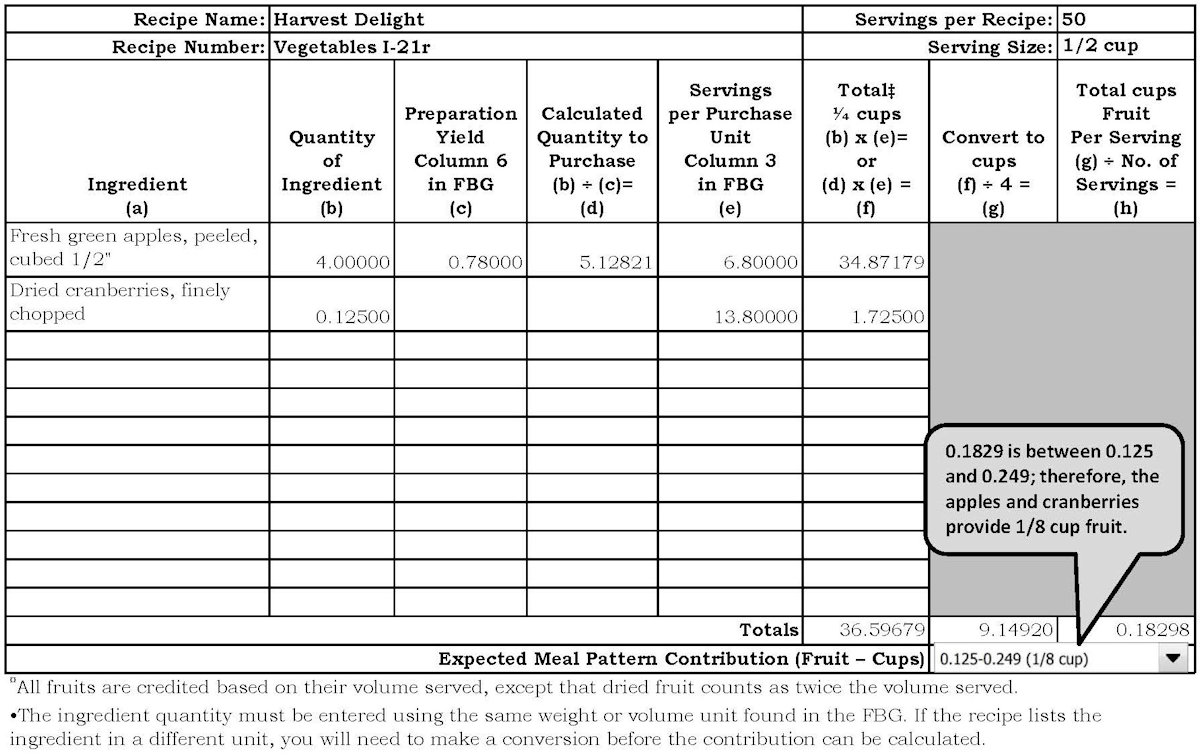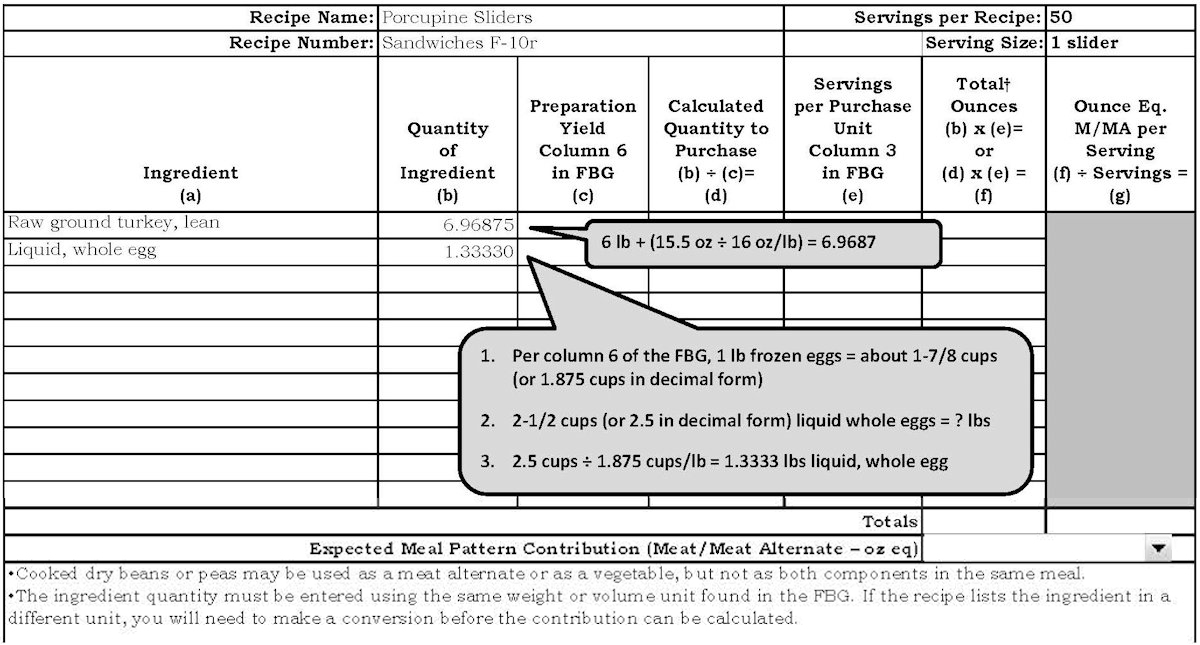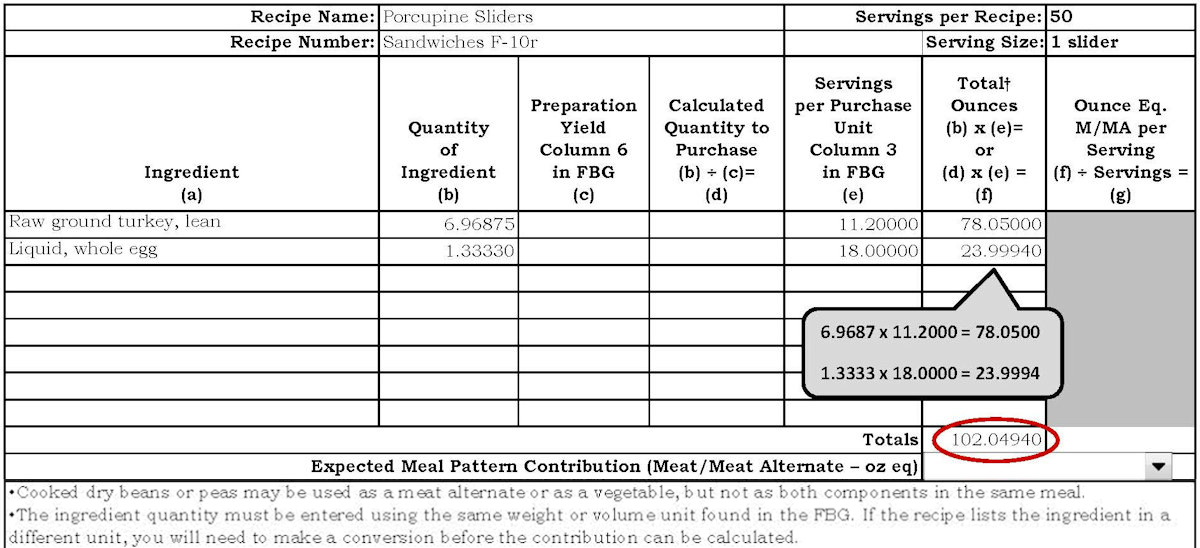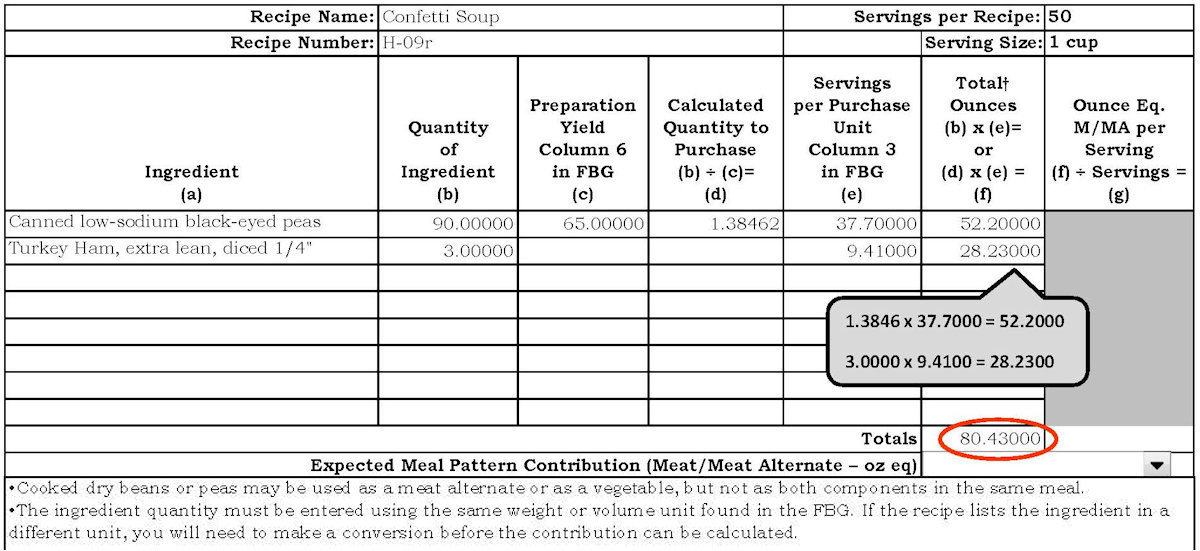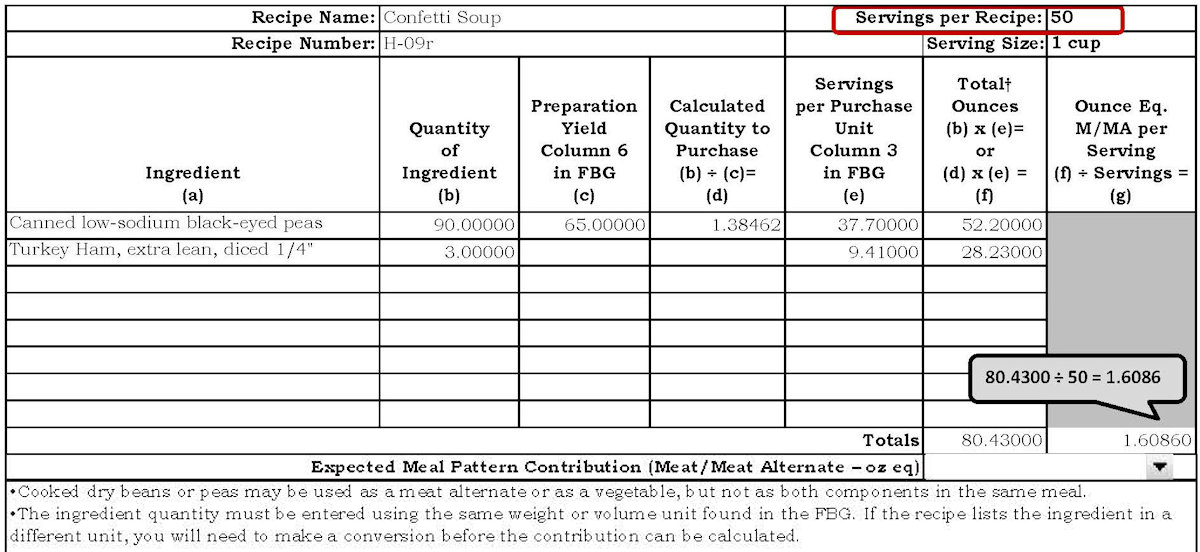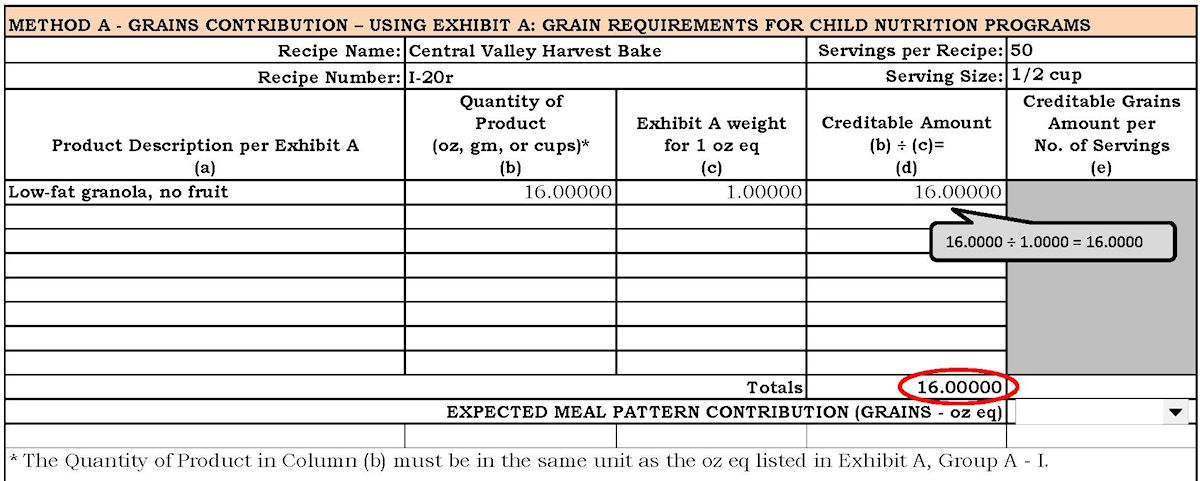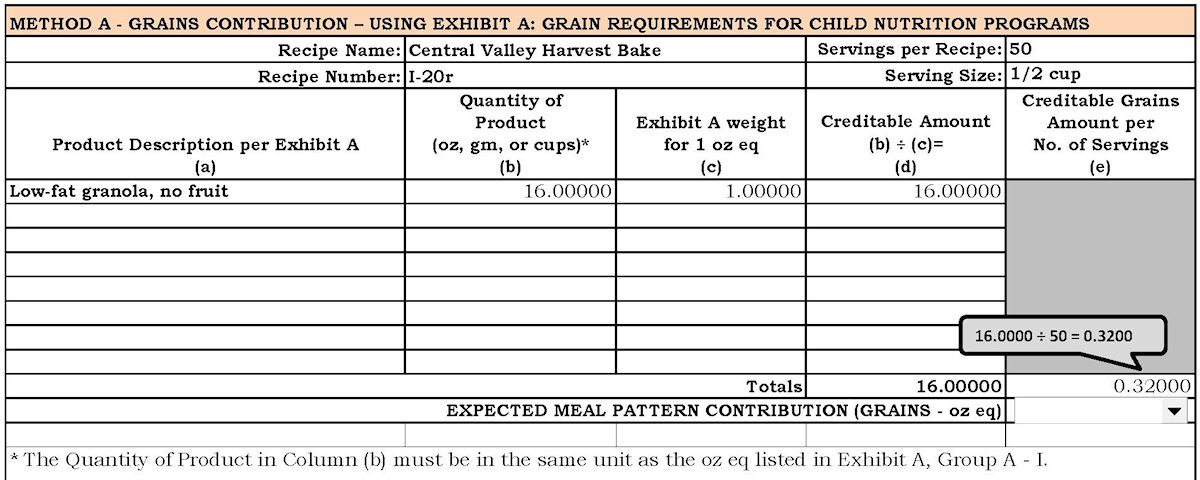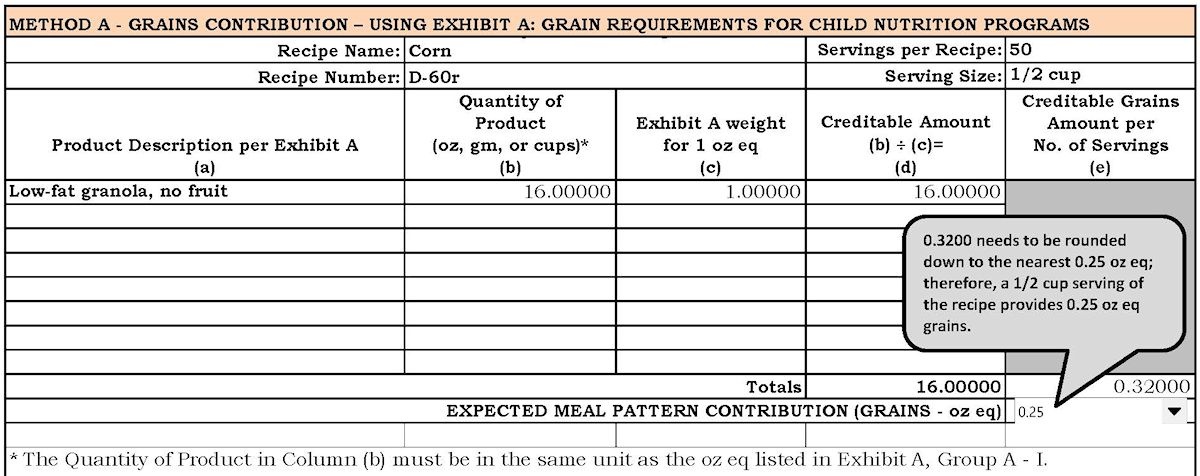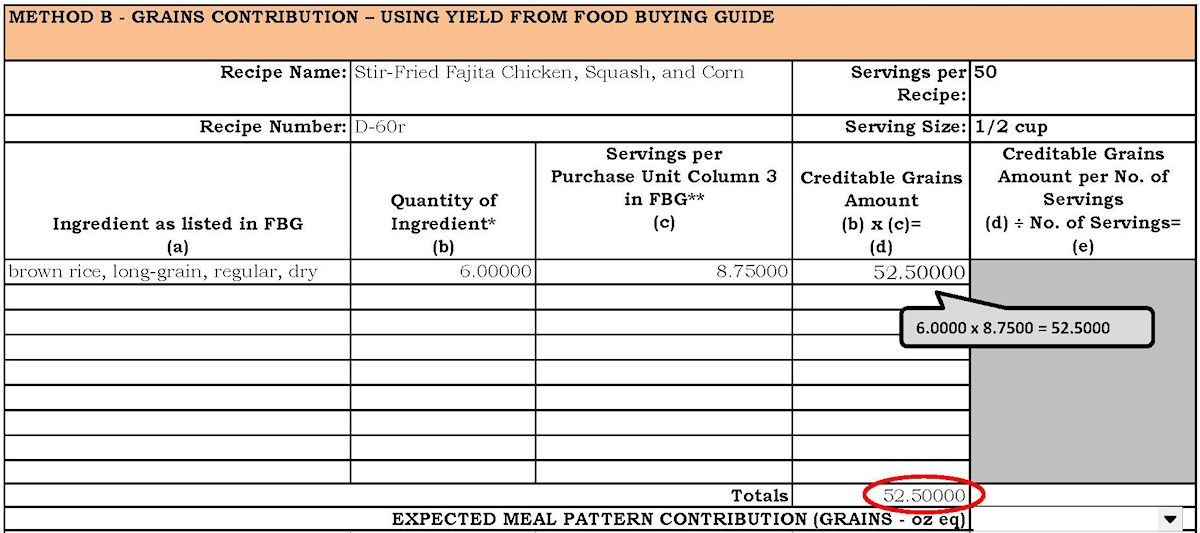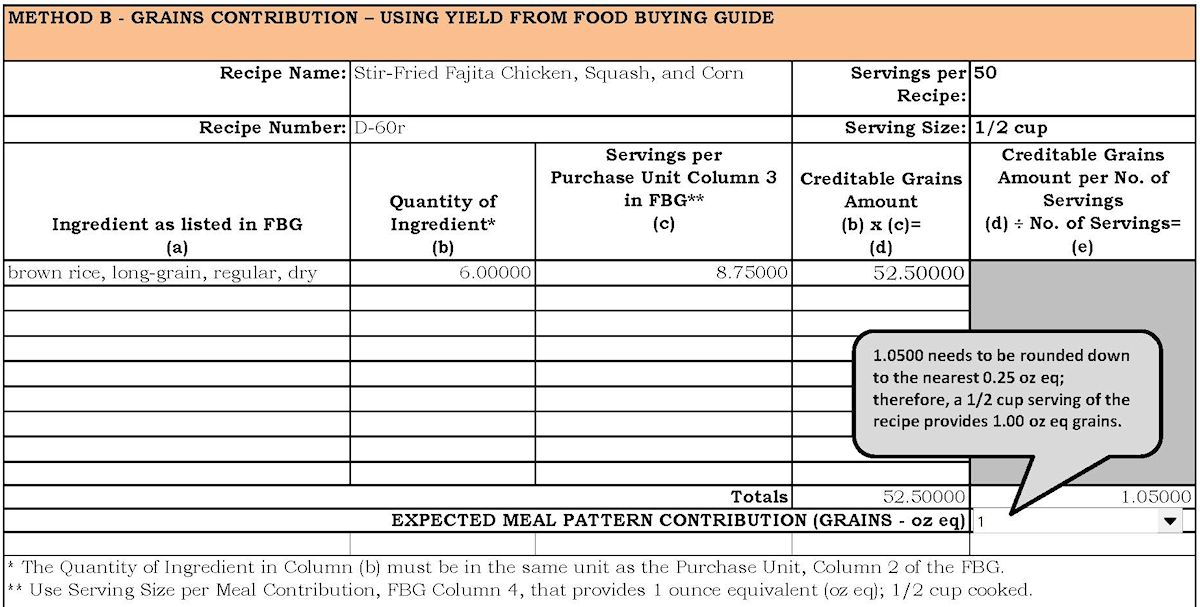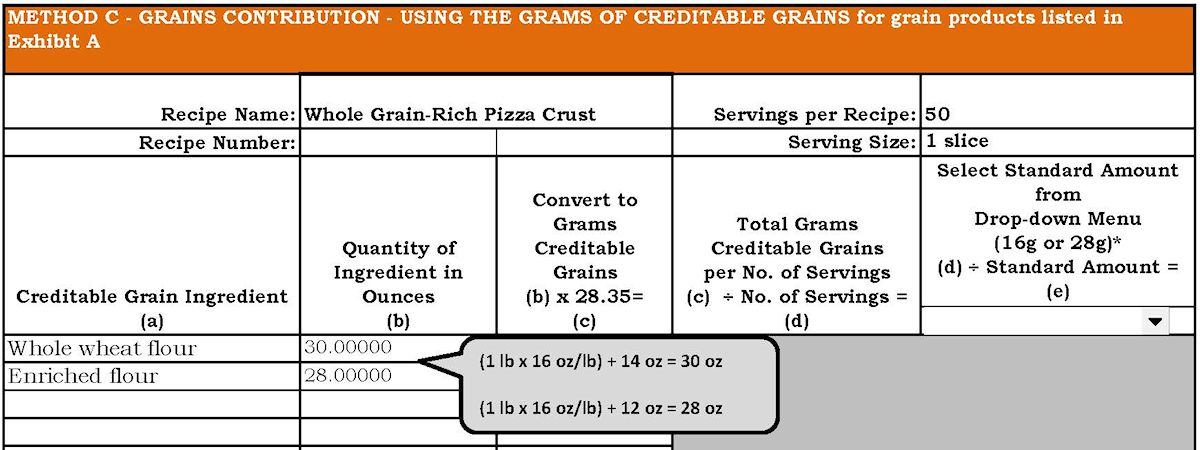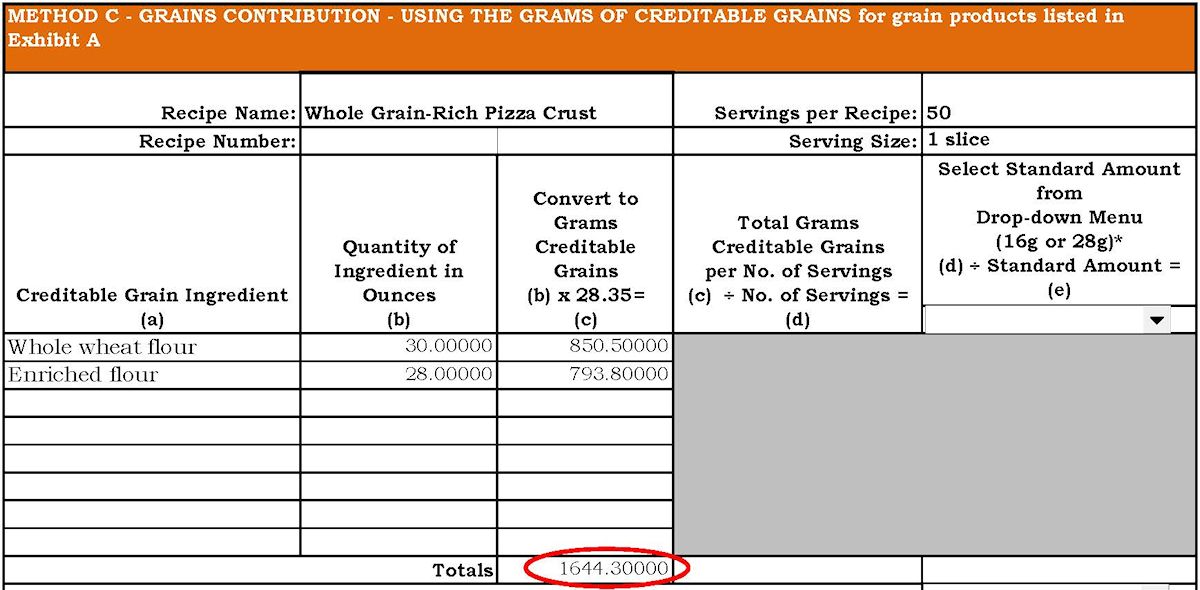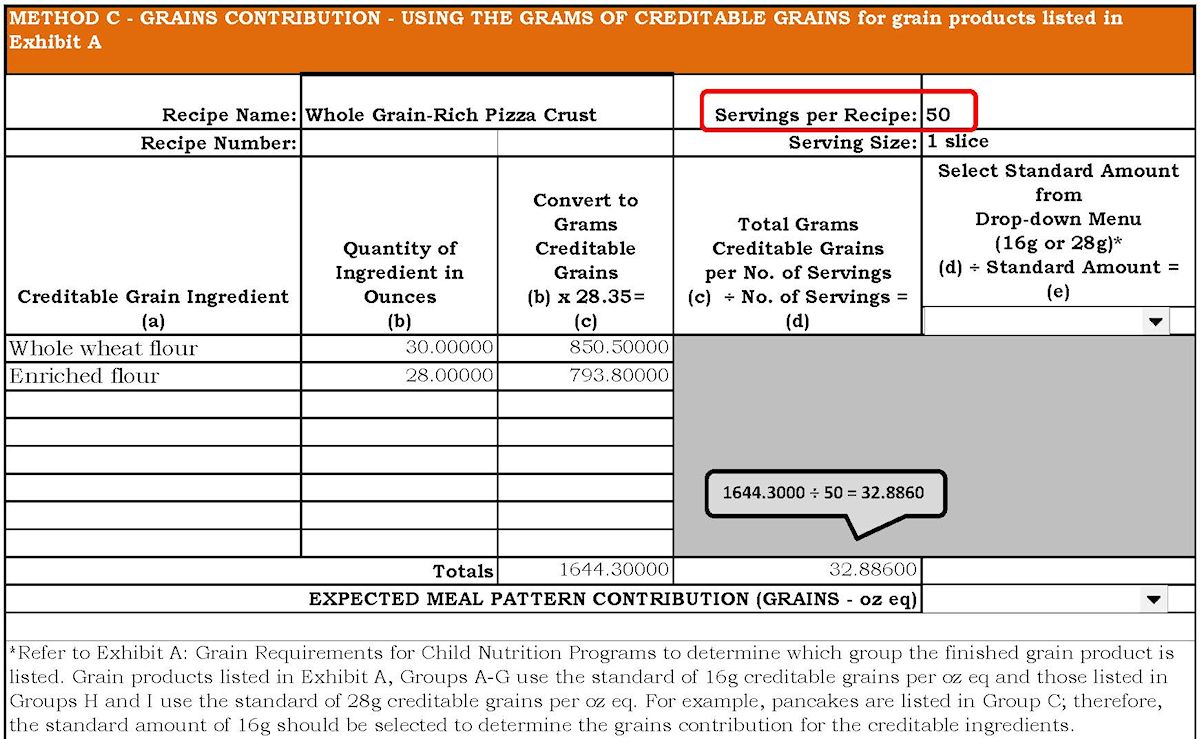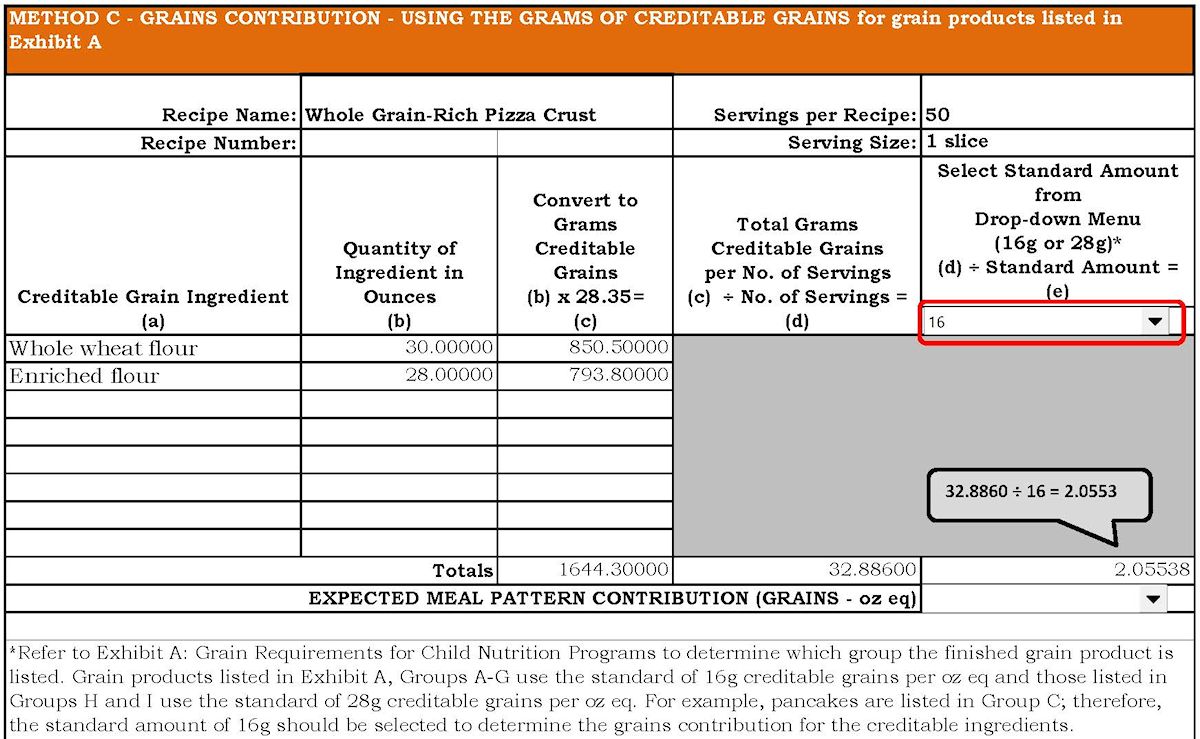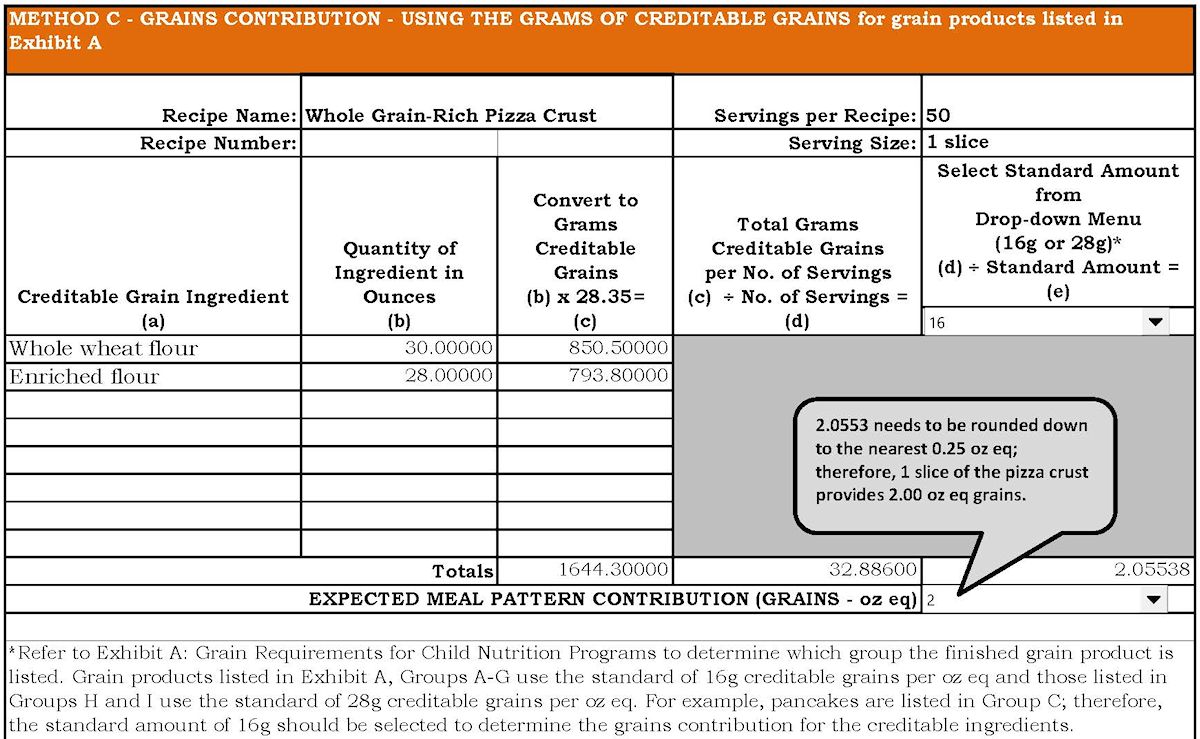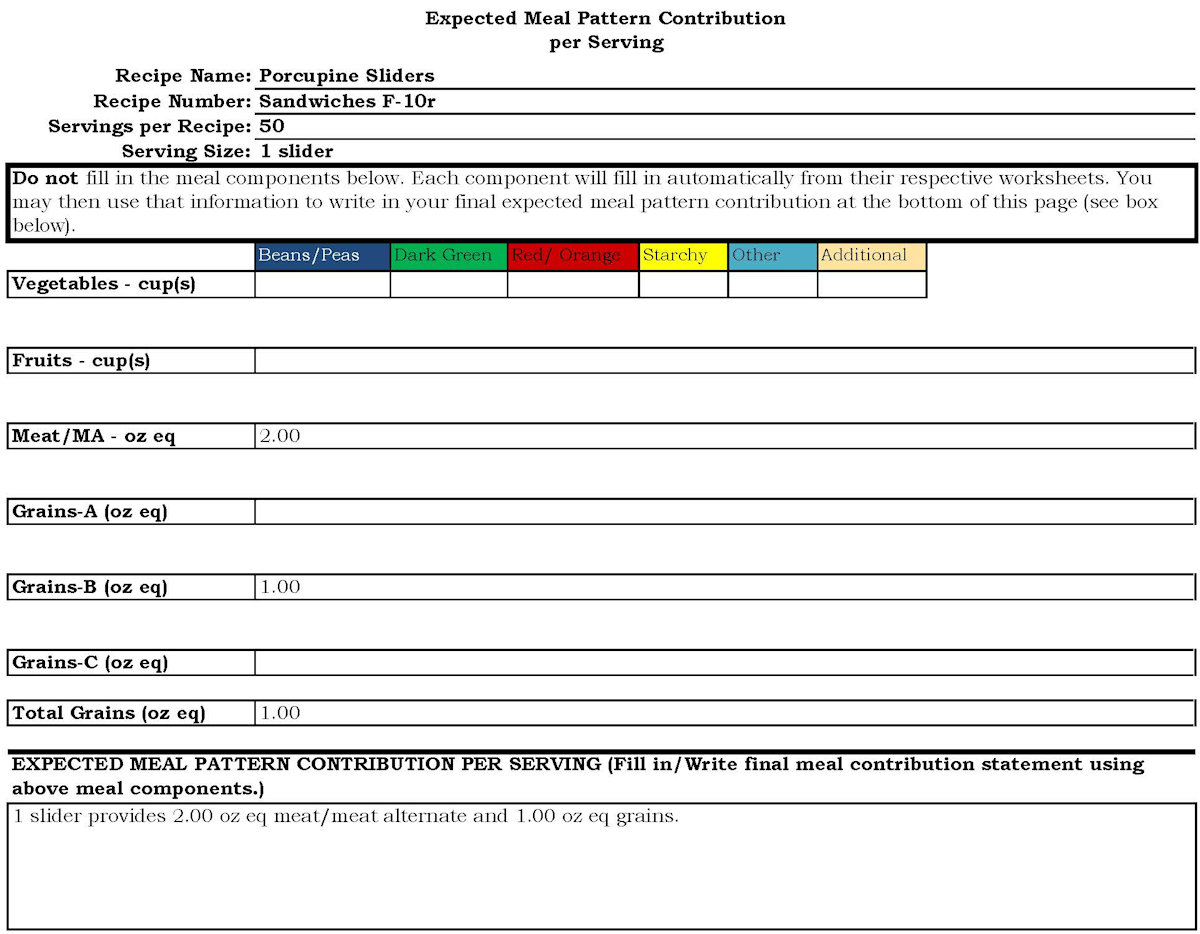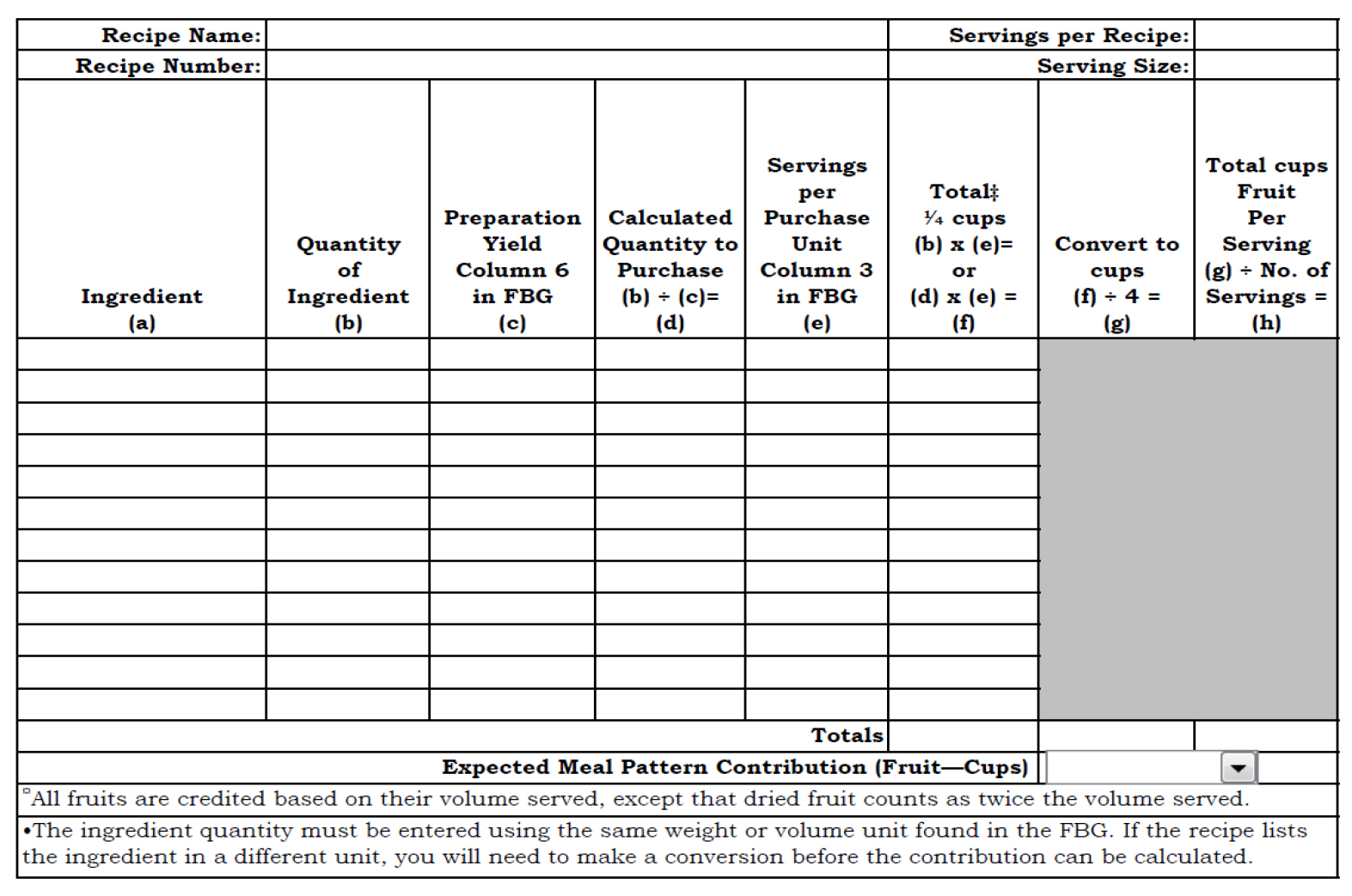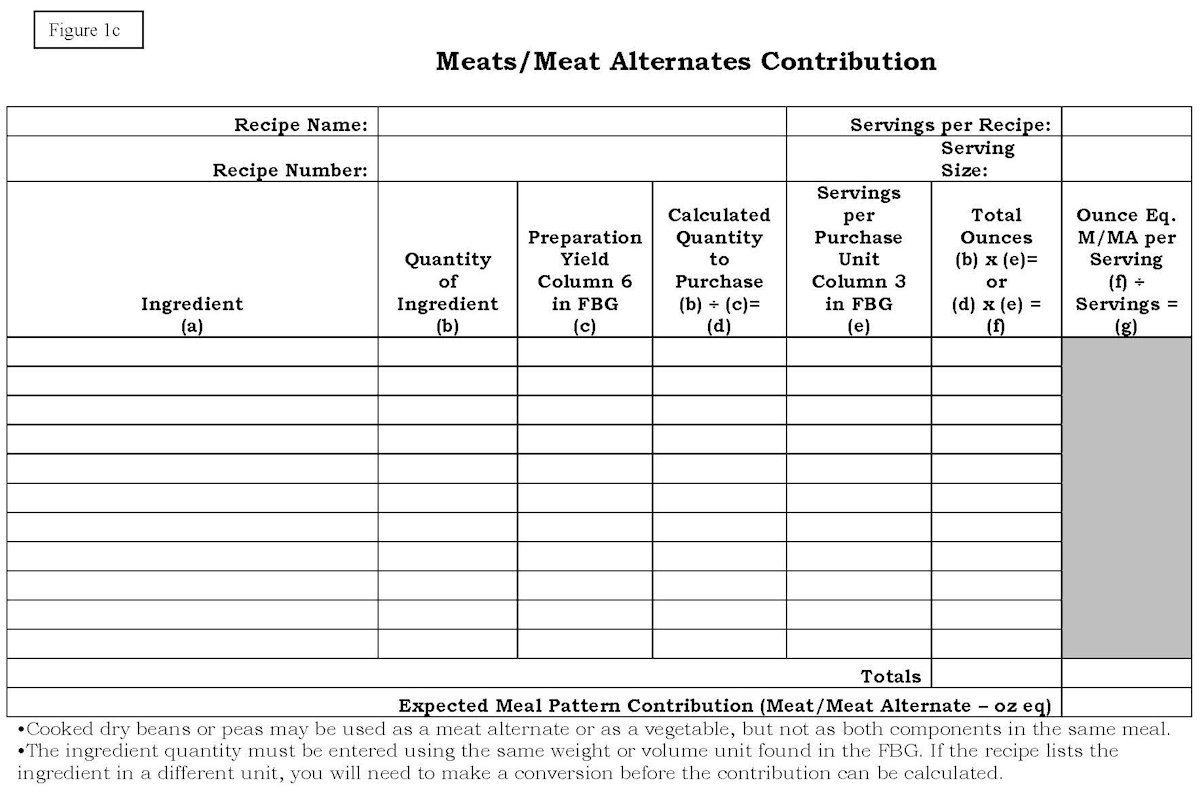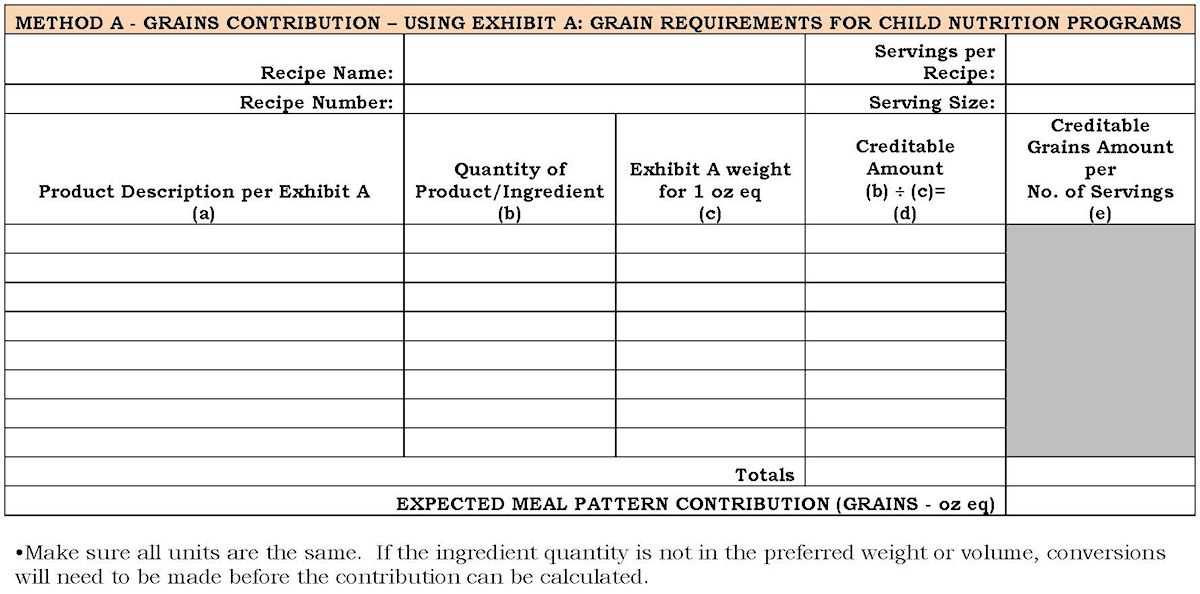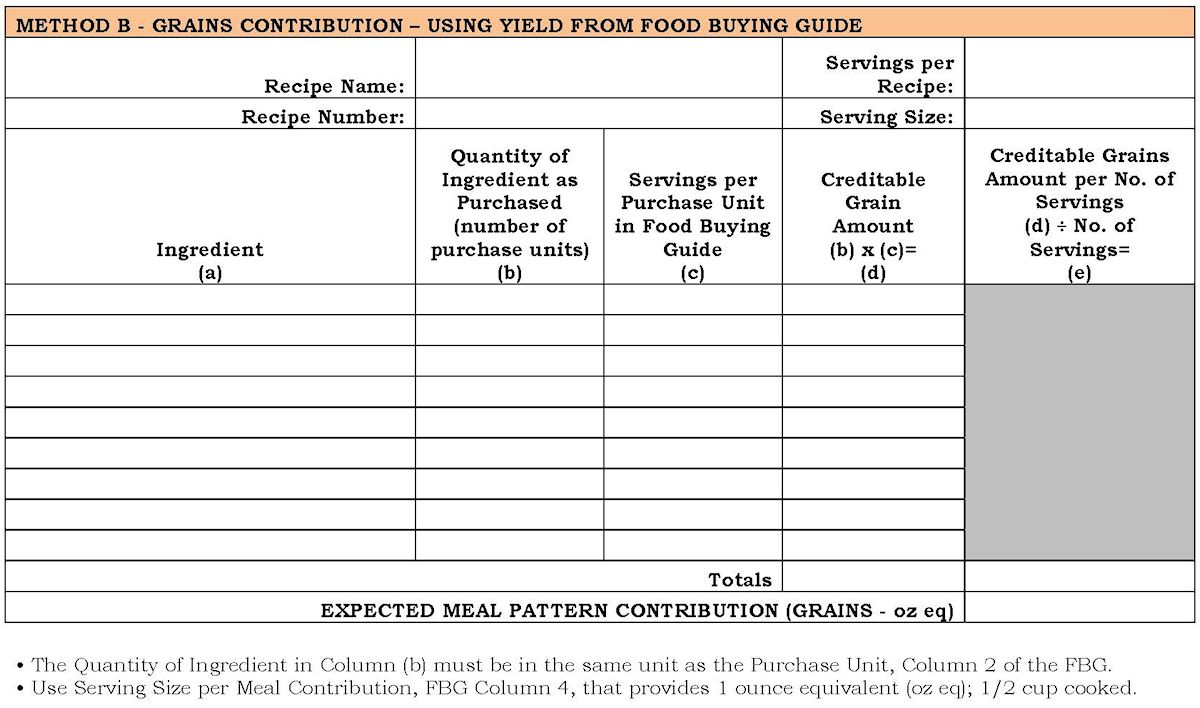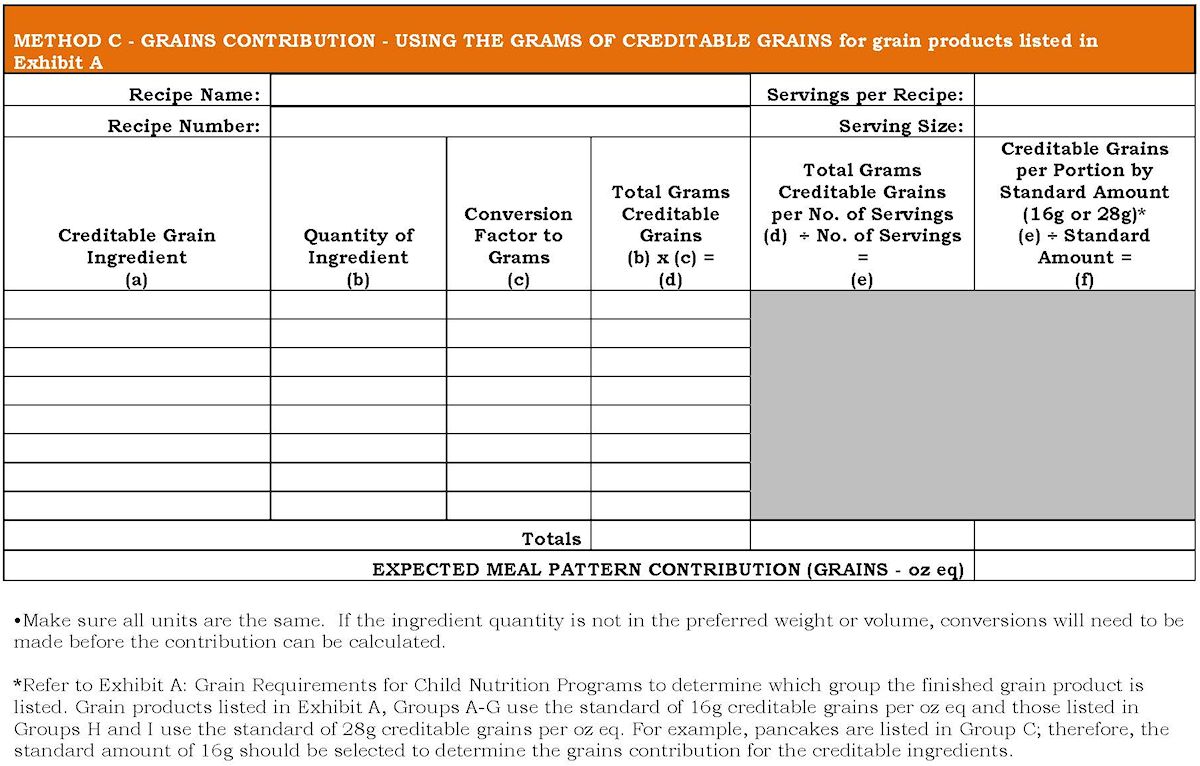Record the ingredient under the appropriate vegetables subgroup heading in “Ingredients,” Column (a).
Example: The Porcupine Sliders recipe contains fresh baby spinach, chopped. List this ingredient on the worksheet under the Dark Green vegetables subgroup in Column (a), as shown.
Enter the ingredient quantity in the “Quantity of Ingredient,” Column (b) using the same weight or volume unit found in the “Purchase Unit” column in the FBG. If the recipe lists the ingredient in a different unit, you must make a conversion before the contribution can be calculated.
Example: The Porcupine Sliders recipe contains 10 oz fresh baby spinach, chopped; 6 oz fresh onions, diced; and 14 oz fresh celery, diced. The FBG lists the Purchase Unit as “Pound” for these items; therefore, they are converted from ounces to pounds and listed on the worksheet in Column (b), as shown.
For canned items, find the appropriate can size in the FBG and/or convert the ingredient quantity to pounds or ounces.
Examples for canned ingredients:
If your stew recipe contains one (1) No. 10 can of diced tomatoes in juice, enter "1" in Column (b), as shown. Do not enter 102 oz (the weight of the No. 10 can). To continue, proceed to section 5, “Examples for canned ingredients” for instructions on how to enter the Servings per Purchase Unit in Column (e).
If your recipe requires a different amount (either more or less) of a canned, drained ingredient than is contained in a No. 10 can, you must determine how many cans you need. First, enter the ingredient amount in Column (b).
The Confetti Soup recipe contains 5 lb 10 oz of canned low-sodium black-eyed peas, drained, rinsed. Convert this amount to ounces: 90 oz. The FBG lists the Purchase Unit as “No. 10 can (108 oz)” and “No. 300 can (15 oz)” for this canned item; hence, the ingredient was converted from pounds to ounces to match the purchase unit and listed on the worksheet in Column (b), as shown.
If your recipe contains 40 oz of canned pumpkin that is served heated, and the purchase unit is in pounds, then convert the ounces to pounds as listed on the worksheet in Column (b), shown. To continue, proceed to section 5, “Examples for canned ingredients” for instructions on how to enter the Servings per Purchase Unit in Column (e).
Record the preparation yield factor in “Preparation Yield” column in FBG, Column (c) for any vegetables ingredients that need to be converted to match the form of the item as listed under “Food as Purchased” column of the FBG.
Example: The Harvest Delight recipe contains 3 lbs each of fresh carrots, ¼ inch slices; fresh sweet potatoes, peeled, cubed 1 inch; and fresh, butternut squash, peeled, cubed ½ inch. The carrots, sweet potatoes, and butternut squash are purchased in their whole form, and the recipe calls for the ingredients to be prepped (e.g., chopped, diced, peeled) prior to adding to the recipe; hence, use the preparation yield factor in "Additional Information" column of the FBG for these three ingredients. The preparation yield factor in the FBG for these ingredients is as follows:
- Carrots, fresh, without tops is 1 lb AP = 0.83 lb (about 2⅔ cups) trimmed, peeled, sliced carrots
- Sweet Potatoes, fresh, whole is 1 lb AP = 0.80 lb peeled, ready-to-cook sweet potato
- Squash, Winter, fresh Butternut whole is 1 lb AP = 0.84 lb ready-to-cook pared squash
Example for canned ingredients: The Confetti Soup recipe contains 90 oz of canned low-sodium black-eyed peas, drained, rinsed. Use the preparation yield factor to determine the amount of drained black-eyed peas provided by a No. 10 can. The preparation yield factor in "Additional Information" column in the FBG is as follows: 1 No. 10 can = about 65.0 oz (9⅜ cups) heated, drained beans
Calculate the quantity of each ingredient to purchase, if a preparation yield factor was used, and record the answer in “Calculated Quantity to Purchase,” Column (d). This calculation is shown for the Harvest Delight.
Example for canned ingredient: For the Confetti Soup recipe, the calculation will provide the number of No. 10 cans of black-eyed peas to purchase.
Enter the Servings per Purchase Unit in Column (e) for each ingredient, using the “Servings per Purchase Unit, Edible Portion (EP)” column of the FBG.
Example: The Harvest Delight recipe contains 11 oz of fresh spinach, coarsely chopped that will be added to the roasted mixture and served. “Servings per Purchase Unit, Edible Portion (EP)” column of the FBG lists three options for spinach, fresh partly trimmed: 30.7, 20.4, and 7.60. By looking at the “Serving Size per Meal Contribution” column in the FBG, 30.7 refers to ¼ cup raw, chopped vegetable, 20.4 refers to ¼ cup with dressing, and 7.60 refers to ¼ cup cooked, drained vegetable. Since the spinach is heated by the roasted mixture when served, 7.60 is the closest option to the form served. 7.60 is entered in the “Servings per “Purchase Unit” column in the FBG,” Column (e), as shown.
Examples for canned ingredients:
Referring back to the canned tomato ingredient that will be added to a stew in Section 2, the entire content of the can is used since the recipe contains diced tomatoes in juice; therefore, a preparation yield is not utilized and Columns (c) and (d) are left blank. Now determine the servings per purchase unit. In the FBG, “Servings per Purchase Unit, Edible Portion (EP)” column lists one option for a No. 10 can of Tomatoes, canned Diced: 49.2. By looking at the next Column in the FBG, “Serving Size per Meal Contribution” column, 49.2 refers to servings of ¼ cup heated, vegetable and juice, so a No. 10 can provides 49.2 ¼ cup servings of heated, diced tomatoes in juice. Enter this amount in the "Servings per Purchase Unit, Column 3 in FBG," Column (e), as shown.
For the Confetti Soup recipe, canned black-eyed peas, drained, rinsed are added to the soup mixture and cooked. There is only one option for a No. 10 can of beans, black-eyed (or peas), dry, canned in the FBG: 37.7. Enter 37.7 in the "Servings per Purchase Unit, Column 3 in FBG," Column (e), as shown.
Referring back to the canned pumpkin example in Section 2, after converting the ounces to pounds the next step is to find the “Servings per Purchase Unit, Edible Portion (EP)” column of the FBG for a pound of pumpkin, canned, which is 7.77. By looking at the next column in the FBG, “Serving Size per Meal Contribution,” Column 4, 7.77 refers to ¼ cup heated vegetable. So, a pound provides 7.77 ¼ cup servings of heated pumpkin. Enter 7.77 in the "Servings per Purchase Unit, Column 3 in FBG," Column (e), as shown:
Enter the total number of ¼ cups for each ingredient by multiplying the numbers in Columns (b) and (e), if a preparation yield is not utilized, or multiplying the numbers in Columns (d) and (e), if a preparation yield is used.
Example: For the fresh spinach in the Harvest Delight recipe, a preparation yield was used, so the number in Column (d) is multiplied by the number in Column (e). This calculation is shown:
The total number of ¼ cups for each vegetable subgroup for the Harvest Delight recipe is then totaled, as circled in red above. For the Dark Green subgroup, the total number of ¼ cups is 5.9375.
Example: For the fresh baby spinach in the Porcupine Sliders recipe, the preparation yield is 1 lb AP = 1 lb ready-to-cook or -serve raw spinach, so the preparation yield was not entered and the number in Column (b) is multiplied by the number in Column (e).
The total number of ¼ cups for each vegetable subgroup in the Porcupine Sliders recipe is then totaled, which is 7.8750 for the Dark Green subgroup, as circled above.
Examples for canned ingredients:
Continuing with the canned tomato ingredient, the number in Column (b) is multiplied by the number in Column (e).
The number of ¼ cups is then totaled, which is 49.2000 for the Red/Orange subgroup, as circled above.
For the Black-eyed peas in the Confetti Soup recipe, a preparation yield was used, so the number in Column (d) is multiplied by the number in Column (e).
The total ¼ cups for each vegetable subgroup for the Confetti Soup recipe is then totaled, which is 52.2000 for the Beans, Peas, and Lentils subgroup, as circled above.
Using the canned pumpkin example, which does not use a preparation yield, the number in Column (b) is multiplied by the number in Column (e).
The total ¼ cups for the canned pumpkin example are then totaled, which is 19.4250 for the Red/Orange subgroup, as circled above.
Calculate the number of cups for each vegetable subgroup and record this number in “Convert to cups,” Column (g). This calculation is done by dividing the number of ¼ cups in Column (f) by four to determine the number of whole cups, as shown.
Calculate the total cups per serving for each vegetable subgroup and record this number in “Total Cups Vegetable per Serving,” Column (h). This calculation is done by dividing the number of total cups in Column (g) by the number of servings per recipe, as shown.
Use Table 7 to determine the decimal equivalent to the nearest portion of a cup for the amount in Column (h) and record the decimal equivalent in Column (i) or use the drop-down menu in Column (i), if using the RAW spreadsheet.
Example 1: The spinach in the Porcupine Sliders recipe provides 0.0393 total cups of vegetable from the Dark Green subgroup per serving as listed in “Total Cups of Vegetable per Serving,” Column (h). Use Table 7 to determine the decimal equivalent to the nearest portion of a cup for 0.0393 and record the decimal equivalent in Column (i) “Decimal Eq. to the Nearest Portion of a Cup” or if using the RAW spreadsheet, use Column (i) to convert the decimal equivalent of 0.0393 to the nearest portion of a cup, and choose your answer from the drop-down menu as shown. The lowest decimal equivalent is 0.125, which is greater than 0.0393.
In this example, the lowest decimal equivalent listed in Table 7 is 0.125, which is greater than 0.0393, so the amount of fresh baby spinach in the recipe is not enough to provide the minimum ⅛ cup vegetable credit for the Dark Green subgroup. Record none in Column (i) “Decimal Eq. to the Nearest Portion of a Cup” or select “0.000” from the drop-down menu if using the RAW spreadsheet, as shown above.
Example 2: One portion of the Harvest Delight recipe provides 0.4520 cups of vegetable from the Red/Orange subgroup. This amount is listed in “Total Cups of Vegetables per Serving,” Column (h). Using Table 7, 0.4520 falls within the decimal equivalent range of 0.375 and 0.499, so record the lower number of the range, 0.375, in Column (i) as the nearest portion of a cup, or if using the RAW spreadsheet, use the drop-down menu in Column (i) to convert the decimal equivalent of 0.4520 to the nearest portion of a cup as shown.
In this example, using Table 7, the amount of fresh carrots, fresh sweet potatoes, and fresh butternut squash in the recipe provides ⅜ cup vegetable credit for the Red/Orange subgroup. Record this amount in Column (j), or if using the RAW spreadsheet, this amount is listed with the nearest portion of a cup from the drop-down menu in Column (i), as shown above.
Determine if there is any remaining amount of vegetables and record this amount in “Remaining,” Column (k) or Column (j) if using the RAW spreadsheet. You will calculate this remaining amount by subtracting the lower value in the decimal equivalent in Column (i) from the “Total Cups Vegetable per Serving,” Column (h). Remaining amounts from the Beans, Peas, and Lentils; Dark Green; Red/Orange; and Other Vegetable subgroups are added together to provide an extra Other vegetables credit, if the total is enough to provide at least the minimum ⅛ cup credit. If there is a remaining amount for the Starchy subgroup, it may contribute only to the Additional vegetable subgroup.
Please note that for the CACFP and NSLP afterschool snacks, add the total amounts from all vegetable subgroups to determine the total amount of vegetables provided in a recipe. For recipes served in the SFSP that contain both vegetables and fruits, add the total amount of vegetables to the total amount of fruits to determine the total fruit and vegetable credit for that recipe.
Example: For the Harvest Delight recipe, there are remaining amounts for the Red/Orange and Other vegetables subgroups. The remaining amounts are added together to determine if they can contribute to the Other vegetables subgroup. In this example, the remaining amounts provide ⅛ cup Other vegetables credit, as shown.
Total the Equivalent Cup Volume amounts in Column (j) including any remaining amounts and record these totals in the Expected Meal Pattern Contribution (Vegetable—Cups) field and on Figure 1g, or these totals will self-populate if using the RAW spreadsheet. Doing so will combine the meal pattern contribution for the vegetables component with the other meal components onto one worksheet for the recipe.




